How to Make the Most Out of Lobby Days

Dr. Amanda Reiman in conversation with Jeremy Marsh, from the Office of Congresswoman Dina Titus
NCIA’s 13th annual Cannabis Industry Lobby Days is rapidly approaching and new and seasoned attendees alike may be wondering how to make the most out of the precious time with electeds’ offices. Meeting with allies and skeptics both present unique challenges and opportunities. To provide advice on how to make the most out of Lobby Days, I reached out to Congresswoman Dina Titus’ office and spoke with Legislative Assistant Jeremy Marsh. Following his advice will help you walk away from Lobby Days feeling accomplished and confident that your message got through.
Stories from the community matter
White papers and data points are fine, but what really moves the needle are stories from the community and the front lines. Tailoring stories to the district/state of the office you are meeting with shows how constituents and local businesses are impacted by policy. These stories are great tools for supportive legislators to take to the floor and their committees. And, when meeting with a legislative office that has supported cannabis in the past, be sure to thank them! Standing up for cannabis is still a risk and those willing to take it should be acknowledged.
Rescheduling and hemp are still areas of confusion
Elected officials are more cannabis savvy now than ever before, but there are still some issues where education is needed. Don’t assume that elected officials, even supporters of cannabis are experts in all of the hot button issues being discussed in the industry. Mr. Marsh explains that rescheduling/descheduling and hemp regulation are two areas where confusion persists. Explain the issue before asking for support, and have some fact sheets ready with background information, as well be willing to answer questions and give context to these issues. Be sure you yourself can clearly explain the issues you are bringing into your Lobby Days visits.
Be early and be flexible
If you’re early you’re on time, if you’re on time, you’re late. This adage was drilled into my head by my Dad (thanks Dad!) and it is a great rule of thumb for Lobby Days. Try to be at least 5 minutes early to each meeting. Time is precious and being early shows that you are taking the process seriously. It also gives you time to collect your thoughts and your breath before heading into a meeting. Lines to get into the Capitol can be long, so keep this in mind before your first meeting of the day. If you are going to be late to a meeting, call the office and let them know. At the same time, be flexible. Schedules are constantly shifting for elected officials, so don’t take it personally if you are meeting with a staffer, or in the hallway outside the office. ALL communication is important, and many vital conversations happen outside the office doors (just watch Veep!).
The economy and public safety are selling points for opponents
Many would argue that meeting with opponents is just as, if not more, valuable than meeting with allies. And although cannabis has gained support from both sides of the aisle over the years, many are still skeptical of changing the laws around cannabis. If you meet with someone who has not traditionally been supportive, discussing the economic and public safety benefits of legalization is a good focus. Cannabis tax revenue has been used to support schools, roads, substance abuse programs, job placement and more. And, research shows that, after legalization, fewer teens are using cannabis, and fewer people are using opiates. You don’t have to be a fan of cannabis to be a fan of legalization.
NCIA’s 13th annual Cannabis Industry Lobby Days is a chance to bring the cannabis issue front and center with lawmakers. Once a source of snickers and jokes, the cannabis movement has become a major political force. Even so, assumptions about those involved in cannabis persist. Being prepared, professional and well versed on the issues will make an impression. And being a part of shedding a positive light on this industry and the people who work in it feels really great.
Committee Blog: Redefining Sleep Therapy – The Role of Cannabis in Decreasing Dependence on Conventional Sleep Medications

Reviewed by NCIA’s Scientific Advisory Committee
Introduction
Insomnia affects nearly 30% of adults, leading many to rely on medications like benzodiazepines and sleep aids that can cause dependency and cognitive side effects. With growing interest in natural alternatives, cannabis has emerged as a potential option.
Cannabis contains compounds like THC and CBD, that interact with the brain’s endocannabinoid system-specifically CB1 receptors that play a role in regulating sleep and wake cycles. Low doses of THC may help with falling asleep and increasing deep sleep, while higher doses of CBD can reduce anxiety and promote relaxation. Lower THC:CBD ratios are typically recommended for insomnia.
While research is still emerging, real-world data is helping fill the gaps. Management Science Associates recently analyzed how cannabis use affected sleep medication use among patients with insomnia—offering new insights into its potential as a safer, more natural alternative.
Methods
This analysis included 81 adults aged 18 and over, diagnosed with insomnia disorders based on ICD-10 codes, who have purchased cannabis products through medical cannabis dispensaries in Minnesota from 2016 to 2022.
Using MSA’s patented HIPAA compliant de-identification technology, we linked each patient’s electronic health records (EHRs) with medical cannabis dispensary transaction records while protecting patient privacy.
We investigated the trends of cannabis products use in patients with insomnia, according to demographics, and quantified changes in sleep medication use over time, using the Defined Daily Dose (DDD) established by the World Health Organization (WHO) to obtain a ratio that reflects the patient’s daily medication intake in a standard measure. We analyzed the differences in medication use before and after cannabis use, and describe the characteristics of patients who experienced a reduction in sleep medication use.
Results: Cannabis in Correlation with Insomnia
- Demographics: Most insomnia patients participating in our study fall within the middle-aged bracket. Almost 50% of the participants were aged 35-50 years, closely followed by 44.4% within the 51–64-year age group.
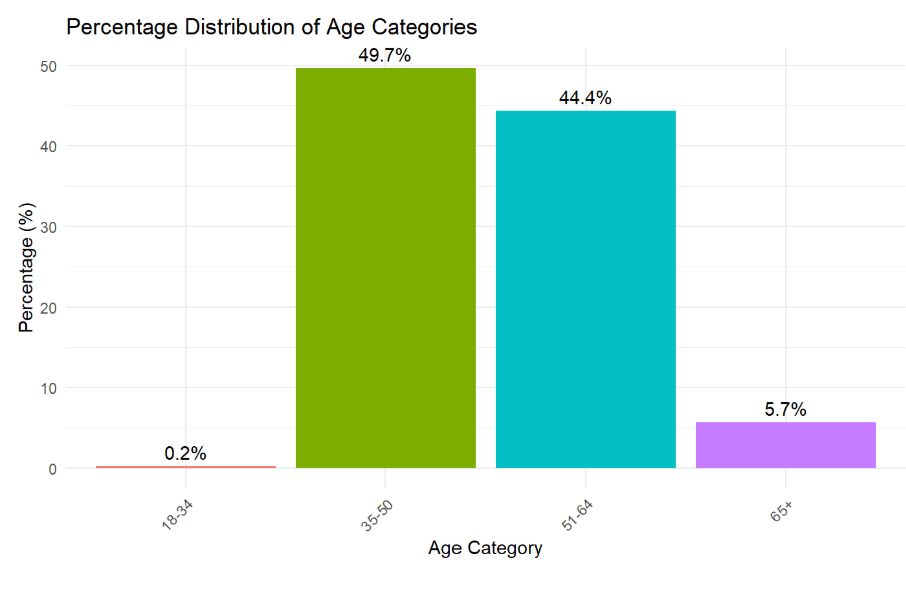
- Product preference overall: Over half of the patients with insomnia (51%) preferred cannabis products with a THC ratio of 19:1.
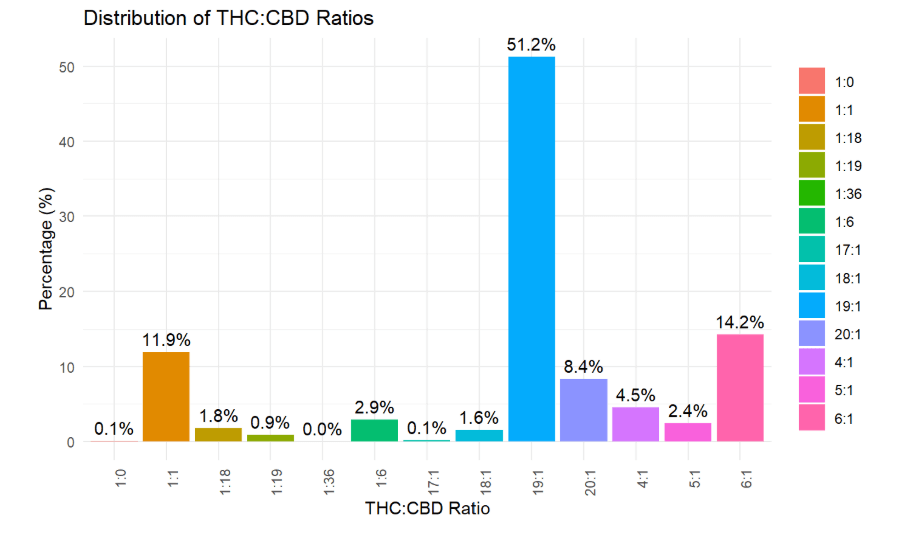
- Most patients with insomnia were using cannabis products in Vape, Tablets and capsule forms.
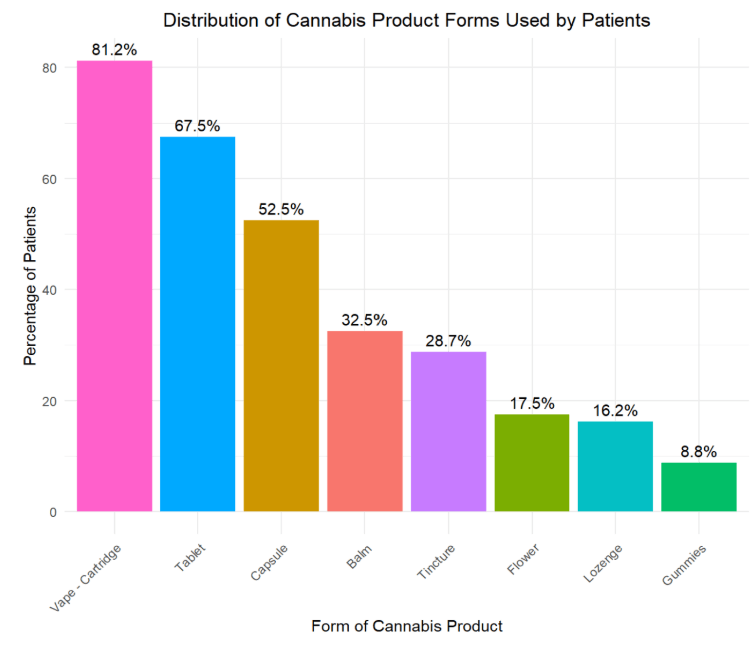
- Reduction in Sleep Medication use of 27%: The average DDD Ratio of Sleep Medications before cannabis use was 2.38, and after starting using Cannabis it was 1.75. The percentage reduction in DDD ratio from Before to After: 26.7%
- Reductions in Sleep Medication Usage Observed Post-Cannabis Use Across Age GroupsPatients using cannabis experienced notable decreases in sleep medication use, with the most substantial improvements seen in individuals aged 50 and older. Specifically, in those over 65 years old we observed a 60% reduction. Meanwhile, the 51-64 age group showed a 39% reduction, and those aged 35-50 observed a 25% decrease in sleep medication prescriptions. Patients 35-50 years old were using higher doses of Sleep medications than other age groups. Patients over 65 years old exhibited a more pronounced reduction in DDD ratios compared to other age groups, this suggests that older patients might benefit more significantly from cannabis use in terms of reducing their sleep medication intake.
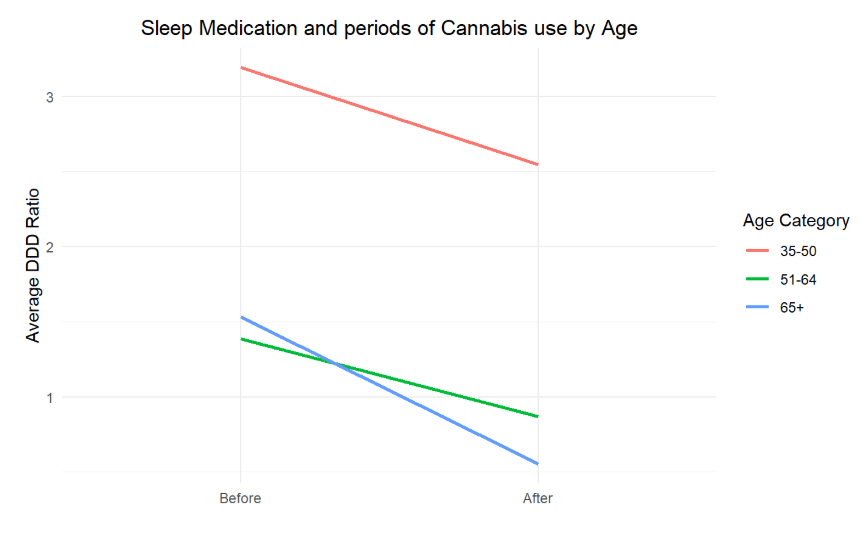
- Reduction by Type of sleep medication: In our analysis, we observed a significant reduction in the use of various sleep medications among patients who began using cannabis, with benzodiazepines showing a particularly notable decrease of approximately 50% of the daily dose. The group of patients that experienced a reduction of sleep medication during cannabis use were mostly using Benzodiazepines, among which the most used were Alprazolam, Lorazepam, Diazepam, and Clonazepam. Benzodiazepines are well-known for their efficacy in treating insomnia but come with risks such as tolerance, dependence, and withdrawal symptoms. The use of benzodiazepines after starting cannabis decreased by 50.17%, highlighting cannabis’s potential as a viable alternative or supplement to traditional sleep medication regimens. The substantial reductions observed here suggest that cannabis might serve as an effective alternative or adjunct therapy, potentially helping to mitigate these risks.
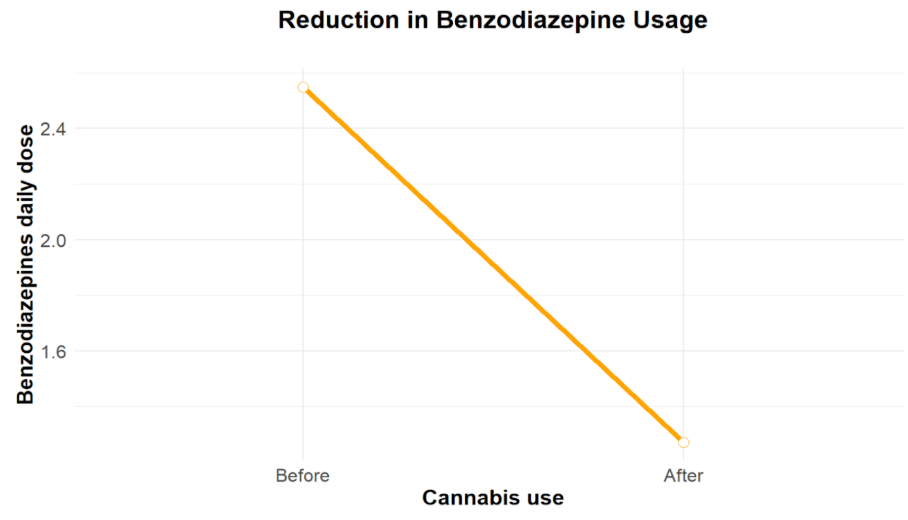
- Reduction by THC:CBD ratio: Although most patients with insomnia in this study were using cannabis products with a ratio of 19:1, the THC:CBD ratios that were most effective to reduce sleep medication use were 4:1, 20:1, and 1:1.
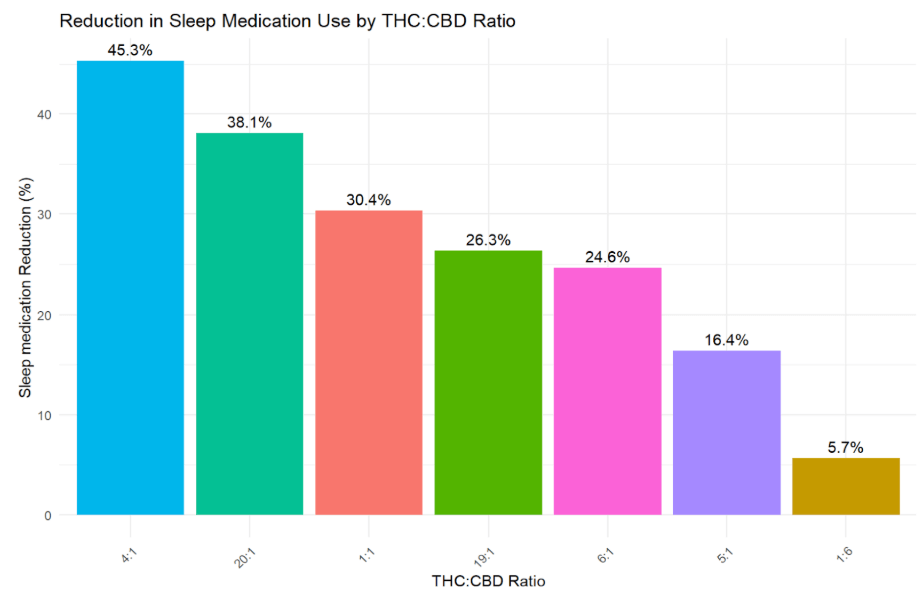
- Milligrams of THC: Cannabis products with higher amount of mg of THC were correlated with higher daily dose of sleep medications. This supports previous literature about the effect of THC on insomnia, where lower contents of THC being most effective to alleviate insomnia are reported.
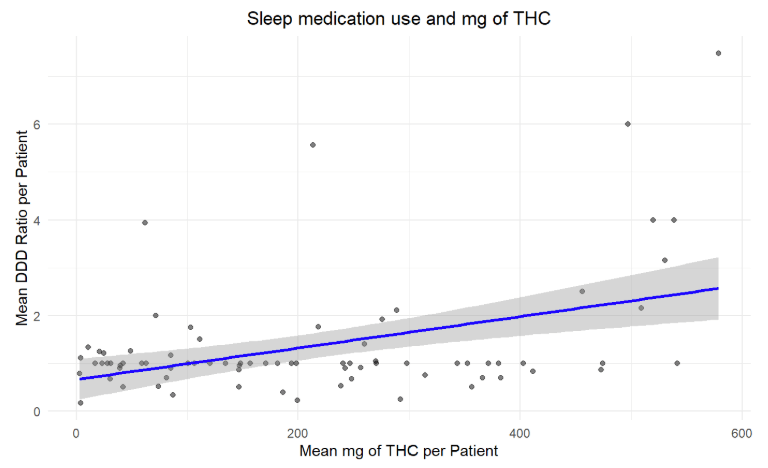
- Product Form and Reduction of Sleep Medication: Patients who were using cannabis in capsules experienced the most reduction in sleep medication use. Capsules can have a higher bioavailability, meaning more cannabis enters the bloodstream compared to tablets, which could make them more effective. Gummies were most used by patients using high dosages of sleep medications at baseline.
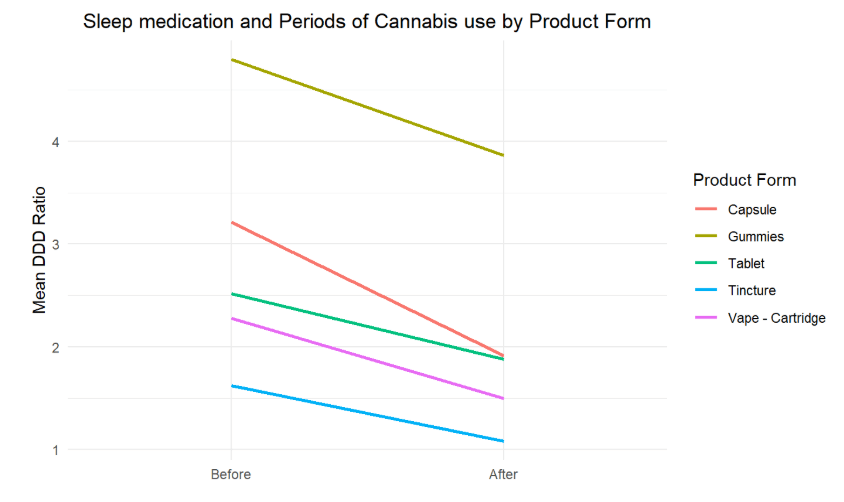
Conclusion
These preliminary findings suggest that cannabis has the potential to reduce the use of traditional sleep medications, particularly among older adults. The preference for specific forms of cannabis in patients using high doses of sleep medications, and the use of capsules in patients who reduced its use, highlight important considerations for patient preferences and adherence. As we continue this research, we aim to further elucidate the mechanisms behind these trends and refine our understanding of how cannabis can be optimized for managing insomnia and sleep disturbances.
Discussion
Our results from this exploratory analysis suggest medical cannabis could reduce the reliance on traditional sleep medications among patients with insomnia. This finding is particularly important given the adverse effects associated with long-term use of conventional sleep aids, such as tolerance, dependence, and cognitive impairment, especially in older adults. The observed reductions in sleep medication use across various age groups underscore the potential of cannabis as an effective alternative to manage insomnia symptoms. Further research is needed to find the significance of these associations among different age cohorts. Notably, the most substantial reductions were seen in patients over 65 years old, indicating that older adults might benefit the most from cannabis therapy in terms of decreasing their sleep medication intake.
The varying impact of different THC:CBD ratios in reducing sleep medication use highlights the importance of personalized medicine. Ratios like 4:1 and 1:1 were particularly effective, suggesting that specific cannabinoid profiles may better address the symptoms of insomnia in certain populations. This aligns with previous research indicating that both THC and CBD play distinct roles in modulating sleep, with THC primarily influencing sleep latency and duration, and CBD offering anxiolytic and sedative effects at higher doses.
Furthermore, the preference for certain cannabis product forms, such as capsules, in patients who reduced sleep medication use, points to the need for considering product bioavailability in treatment plans. The higher bioavailability of capsules compared to other forms like tablets may lead to more effective symptom relief, thereby reducing the need for conventional medications. This aspect of cannabis therapy could be crucial for optimizing treatment outcomes and enhancing patient adherence. These findings support previous studies about the potential of cannabis as a valuable tool in managing insomnia and call for further research to understand the mechanisms underlying these effects.
Next Steps
Longitudinal studies in large and diverse populations are essential to evaluate the long-term safety and effectiveness of cannabis, particularly in terms of dependency, cognitive function, and overall sleep quality. The development of comprehensive clinical guidelines informed by high-quality evidence will be crucial in integrating cannabis into insomnia treatment safely and effectively. By continuing to explore these avenues, we aim to refine our understanding of cannabis’s role in sleep therapy, ultimately providing more tailored treatment options for patients suffering from insomnia.
If you are interested in learning more or getting involved with MSA by being a prominent leader in cannabis research, we’d love to hear from you. Additionally, as a cannabis operator, you’d receive valuable insights into your cannabis business. You can reach out to Madeline Grant at mgrant@msa.com to schedule an introductory call.
Committee Blog: Mitigating Risk in Your Cannabis Workforce

We in the cannabis industry are all too familiar with working in an industry with high levels of risk. These risk factors can come in a variety of different forms—from federal intervention to banking to security. However, an aspect of risk that’s often overlooked in the cannabis industry is related to one of the most vital aspects of a functional and compliant cannabis operation—the employees.
Here we will look at risk and risk mitigation techniques involved with identifying the right individuals for hiring in this regularly changing industry, employee training, and the best onboarding/ offboarding practices.
Hiring the Right Folks
I’ve worked with clients across over a dozen different cannabis markets and one of the most recurring pieces of insight I get from newer business operators is a desire to work small. The fewer people the better. In many instances I’ve had clients who wish to not hire or pay anyone full-time at their cannabis operation except for themselves.
While this can obviously decrease overhead costs by having a small personnel pool, it’s virtually inconceivable to have a regulated and compliant cannabis operation—be it a cultivator, manufacturer, retailer, or even a microbusiness—without well-trained and well-qualified individuals within the business. No one can do this work on their own, so you will need to hire the right folks for the job.
From a risk mitigation standpoint, having the right processes in place is essential. This involves finding people with industry experience or at least relevant experience to their job duties, running thorough background checks for new hires, and assessing the specific needs of your own business operation from a personnel standpoint. What does this last point mean? Every cannabis operation is unique, and requires different demands of employees. For example, a manufacturer may want to make sure they have individuals comfortable with industrial machinery associated with extraction or have knowledge in packaging and labeling and the state-specific requirements for such. Human error can increase the overall risks of an operation, so it’s critical to find good people for the business.
The Importance of Training
No matter how knowledgeable and experienced an individual may be, they will still need to be trained in a myriad of standard operating procedures, employee handbooks, and other processes. This is critical not just for a cannabis operation in general, but also for the business specific needs for each business’s unique structure.
Training is important not just from an onboarding perspective (more on that later!) but also for recurring purposes such as when regulations and laws change. We have all seen how states decide to update or modify rules and regulations, so it’s important to stay compliant with even the smallest changes that can impact a business. Being out of compliance with even minor updates can result in steep fines or even revocation of a cannabis license.
As a tool for employees, training throughout their time at a business allows them to become more comfortable with operational readiness, improves one’s overall effectiveness with problem solving, and offers employees better resources to report any wrongdoing they may encounter. Well-trained and knowledge employees make for a better managed business and a business that’s taken proactive steps to reduce risks within their workplace environment.
The Most Critical Employee Related Steps
While air travel is safe, the most dangerous times are during takeoff and during landing. In many ways, this is applicable to employees and working in cannabis. When onboarding a new employee, it’s crucial to mitigate risks appropriately. This means, as mentioned previously, making sure the employee in question passes a robust background check. This is more often than not required by states too, but the strictness and the disqualifying factors an individual may vary.
Additionally, when an employee leaves a cannabis business, appropriate offboarding procedures are essential. Diversion is one of the biggest threats which a cannabis operator will face. Luckily, there are steps to mitigate this and the easiest one often relates to employee training and offboarding. Should an employee be identified as having engaged in diversion, offboarding steps—which may include changing SOPs, having a detailed exit interview with said employee, updating keycards or access points for cannabis and cannabis products, and/or increasing physical security personnel on or around a premises—are valuable to have in place.
Offboarding is critical to compliant operations and operations which have taken appropriate steps to reduce risk. Documentation and fair, timely communication through a potentially emotionally charged process can assist with covering one’s legal and financial bases and ensure for a smoother transition between employees working in the same or similar capacities.
Risk with Employees
On the whole, yes there are risks associated with anything and everything human related. This is true beyond just the cannabis space but is particularly unique here given the overall higher level of risks associated with working in this industry. However, every risk can be assessed and mitigated accordingly and this is also true with the people involved. Hire right, train well, and handle crises well and the risks overall can be more adequately addressed.
Make Your Voice Heard: Why You Can’t Afford to Miss NCIA’s Annual Lobby Days & National Stakeholder Summit

It’s no secret that the cannabis industry is in dire need of reform. Businesses are struggling, consolidation is rampant, and communities continue to bear the costs of prohibition. At the same time, partisan gridlock has made progress at the federal level more challenging than ever. The cannabis industry—its business owners, employees, and advocates—feels the weight of uncertainty, cynicism, and frustration.
But one thing is certain: change doesn’t happen without action. That’s why there’s no better investment in the future of your business and the industry than attending NCIA’s 13th Annual Cannabis Industry Lobby Days and the inaugural National Stakeholder Summit in Washington, D.C., from May 13-15, 2025.
A New Era of Advocacy Begins with the National Stakeholder Summit
For the first time, we’re launching the National Stakeholder Summit, a deep dive into the policy challenges and regulatory shifts shaping the cannabis industry. This is where business meets policy, and where industry leaders set the stage for the advocacy that follows.
NCIA members enjoy complimentary access to the Summit, while non-members can attend for just $100. If you’re not yet a member, there’s never been a better time to join NCIA and unlock full access to this high-impact event.
Lobby Days: The Most Important Advocacy Event of the Year
After the Summit, NCIA’s 13th Annual Cannabis Industry Lobby Days provide a unique opportunity for cannabis professionals, business owners, and advocates to directly influence federal policy. As the industry continues to expand, engaging with lawmakers is essential to advancing sensible regulations, protecting businesses, and pushing for federal reform.
At Lobby Days, attendees will educate members of Congress and their staff on key industry priorities, including:
✅ Banking access
✅ 280E tax reform
✅ Federal legalization
✅ Criminal justice reform
✅ Sensible regulations for hemp products
Even more importantly, this is your chance to share your personal story. Lawmakers need to hear directly from industry professionals about the real-world impact of federal policies. Personal engagement can significantly influence legislative decisions and demonstrate the economic power and legitimacy of the cannabis industry.
Why Showing Up Matters
Beyond advocacy, Lobby Days offers unmatched networking opportunities, allowing you to connect with other business leaders, policymakers, and industry stakeholders. These relationships are critical for staying informed, forming strategic partnerships, and ensuring long-term success in the cannabis space.
This isn’t just about being seen—it’s about being heard. And the best way to ensure your voice carries weight is by standing with the largest and most influential cannabis trade association in the country.
Reserve Your Seat at the Table
NCIA’s Lobby Days is an exclusive, members-only event. Not yet a member? Join today to secure your spot and be part of the movement shaping the future of cannabis.
Already a member? Register now to stay up to date on our agenda, training sessions, and more.
Want to Maximize Your Impact?
Consider sponsoring Lobby Days to amplify your company’s voice and position yourself as a leader in cannabis advocacy. Sponsorship opportunities help you stand out before, during, and after the event.
Be in the room. Be part of the movement. Join us in Washington, D.C.
I look forward to seeing you there—just don’t forget to pack comfortable shoes!
Michelle Rutter Friberg
Director of Government Relations, NCIA
Proven Strategies to Maximize Cannabis Marketing ROI: Key Insights & Free Tools

Maximizing Cannabis Marketing ROI: Key Insights from NCIA’s Latest Webinar
In an increasingly competitive cannabis market, understanding how to measure and maximize your marketing and PR efforts is essential. Our latest Industry Essentials webinar brought together top industry experts from NCIA’s Marketing & Advertising Committee to break down effective strategies for increasing visibility, proving ROI, and aligning marketing efforts with business growth.

Key takeaways from the discussion included:
- PR isn’t just about press—it’s about measurable business impact. Understanding how earned media translates to sales and brand credibility is crucial.
- Data-driven marketing decisions lead to stronger ROI. Identifying the right KPIs ensures you’re focusing on what truly moves the needle.
- A strong brand strategy outperforms disconnected tactics. Thoughtful, integrated campaigns create long-term success rather than short-term spikes.
Access Exclusive Resources from Our Panelists
📺 Watch the full webinar on demand: Register Now
📖 Learn how to measure PR success: Avaans Media’s Guide for CMOs
📊 Optimize your marketing strategy: Get a free audit & consultation from Hybrid Marketing
🔢 Put your numbers to work: Try the KPI Calculator
Stay ahead of industry trends and ensure your marketing efforts deliver real results. Catch the replay now and level up your strategy!
Member Blog: How Cannabis Insurance Can Safeguard Your Business from Legal Risks

The cannabis industry is growing rapidly, yet with this expansion comes a complex array of legal risks. From compliance with regulations to managing liability claims, cannabis businesses face unique challenges that require specialized insurance solutions. Cannabis insurance provides essential protection, enabling businesses to operate legally and securely while minimizing potential financial hazards.
This article explores how cannabis insurance can safeguard your business from legal risks, outlining vital coverage options and the importance of risk management in this evolving industry.
Understanding Legal Risks in the Cannabis Industry
Businesses in the cannabis industry need to grasp the legal difficulties that affect them. The cannabis business operates under strict regulatory parameters which make businesses exposed to major market challenges stemming from compliance problems and legal complications. Several of the most frequent legal risks encompass:
Breaches of Regulatory Compliance
All cannabis companies must follow every law enacted by the federal government and state authorities, together with regional ordinances. Business operations face severe consequences when any compliance violation occurs, regardless of intention since it leads to potential business shutdowns or heavy fines together with legal action. Insurance coverage helps pay for the legal expenses that arise from compliance cases.
Lawsuits for Product Liability
Users may encounter safety risks when using cannabis products that include edibles and tinctures, and vaporizers. Experiencing negative reactions from customers who believe their product is faulty could trigger expensive legal proceedings for a business. The insurance protects companies in case clients bring product liability claims.
Claims Related to Employment
Possible legal challenges arising from workplace discrimination combined with unfair dismissal and harassment issues affect all industries including cannabis. EPLI provides coverage to pay for legal costs and compensation required in employment claims.
Property and Theft Hazards
The expensive marijuana stock maintained by cannabis companies makes them especially vulnerable to theft incidents. Business disruption can occur because of fire incidents combined with vandalism or natural disasters damaging property. The coverage provided by property insurance enables businesses to recuperate after experiencing such events.
Cybersecurity Risks
Cannabis companies currently use online systems to store sensitive corporate and client information. Businesses which obtain cyber liability insurance gain safeguarding against financial consequences and data breach losses together with hacking incidents.
Key Insurance Policies to Protect from Cannabis Operations
Businesses operating in the cannabis industry must buy specialized insurance plans that protect them against relevant dangers. Several mandatory insurance protection plans exist, which include:
1. General Liability Insurance
General liability insurance helps businesses avoid legal expenses after claims from external entities when these entities suffer property damage or experience customer injuries. Every cannabis business needs this policy for essential protection purposes.
2. Product Liability Insurance
Product liability insurance protects businesses from legal consequences that stem from releasing dangerous defective products onto the market. Additions to legal costs and settlement payments, together with damages awarded during legal cases, fall under the scope of this insurance.
3. Workers’ Compensation Insurance
Through the workplace policy employees can receive medical care together with income benefits when their job injuries occur. The manual nature of cannabis businesses necessitates workers’ compensation insurance due to the high risks of workplace injuries.
4. Property Insurance
The protection given by property insurance provides monetary compensation for physical structures including dispensaries along with warehouses and cultivation buildings. This policy protects organizations by paying for costs arising from fire damage as well as theft events and natural disasters.
5. Employment Practices Liability Insurance (EPLI)
Employment Practices Liability Insurance which you may also know as EPLI, protects cannabis businesses from employment-related lawsuits that might occur when employees face discriminatory action and harassment at work and unfair termination.
Benefits of Cannabis Insurance for Legal Protection
Investing in cannabis insurance provides numerous benefits in addition to financial protection. Here are several important advantages:
1. Ensures Compliance with State Laws
Numerous states mandate that cannabis companies possess certain types of insurance to fulfill their licensing obligations. Possessing appropriate coverage guarantees adherence and avoids licensing problems.
2. Minimizes Financial Losses
A business unprepared with insurance faces financial challenges when trying to afford costs of court procedures and payment of settlements. Insurance alleviates the monetary stress of legal actions and claims.
3. Enhances Business Credibility
Being insured at proper levels represents both professional conduct and responsible management of accountability. A cannabis business protected by proper risk management attracts more customers and investors together with business partners who demonstrate trust in its operations.
4. Protects Business Owners and Employees
Insurance provides legal advocacy along with monetary support when defending against lawsuits to shield both organizations and their personnel against unpredicted legal responsibilities.
5. Reduces Business Interruptions
Unexpected incidents, such as theft or property damage, can disrupt operations. Insurance helps businesses recover quickly by covering losses and repair costs, minimizing downtime.
Choosing the Right Cannabis Insurance Provider
Choosing the appropriate insurance company is essential for thorough coverage. Here are several important factors to keep in mind:
1. Industry Experience
Select an insurance provider that specializes in cannabis policies and comprehends risks particular to the industry.
2. Policy Customization
Seek out providers that deliver customized coverage choices suited to your business requirements, regardless of whether you run a dispensary, cultivation site, or distribution firm.
3. Reputation and Financial Stability
Investigate the insurer’s financial stability, customer feedback, and claim handling effectiveness to guarantee dependability.
4. Compliance Knowledge
Due to variations in cannabis laws among states, collaborate with an insurance provider that remains informed about changing regulations to guarantee compliance.
Conclusion
Risk management for the cannabis industry requires proactive strategies since insurance serves as an essential component among such approaches. Companies that invest in wide-reaching cannabis insurance coverage protect themselves from regulatory fines and legal actions as well as property damage and multiple types of liabilities.
Businesses that adopt proper insurance coverage mechanisms get protected from financial instability and also gain regulatory compliance while enhancing their credibility and building enduring business success. The cannabis sector’s development requires businesses to obtain suitable coverage that minimizes their risks and enables secure business operations.
Member Blog: The Cannabis Crisis Plan – Business Insurance for the Future

Is Your Cannabis Business Prepared for the Unexpected?
In an industry as scrutinized as cannabis, a crisis can escalate quickly—having a solid plan in place can make all the difference.
Given its unusual balance between federal illegality and regional legality, the cannabis industry sometimes feels like it’s under a microscope. Indeed, because of this microscope, a cannabis crisis can blow up fast. From product recalls to regulatory and legal issues, the Avaans Media team has worked with cannabis companies – and non-cannabis companies – can face in moments of crisis. No crisis is ever “planned.” Because the very nature of a crisis is that it creeps up when you least expect it. Think it can’t happen to you? Seventy-nine percent of companies will experience a crisis with service disruption and media implications.
A moment of crisis doesn’t even have to be the brand’s fault. Many companies have gotten caught up in social media rumors, it could have to do with police, government officials or product recalls and yet in those cases, it is the company’s crisis to handle.
A crisis plan can be the unsung hero of an emergency. Putting a crisis plan in place may seem tedious, but a cannabis crisis is high stakes, and understanding when, who and how your company will handle a moment could save you millions in legal and PR fees, while also preserving the valuation of the brand, and the reputation in the eyes of customers, regulators, and the media. Crisis PR professionals can assess a situation quickly and guide you through this process. And a crisis plan will help you in those early critical moments. Tabletop exercises and media training are the muscle behind a crisis response.
Yet, if you find yourself in a crisis without a plan in place, there are three strategies to employ in a crisis.
Follow the traditional process of response.
We see this played out repeatedly, the traditional response to a crisis is to address the facts publicly, acknowledge the concern and the problem, apologize, and rectify. This is a well-worn process, and the media are all very familiar with this process.
It’s important with this strategy to consider the methods of response and that the urgency matches the level of the crisis. Spokesperson, media format, and timing are essential elements in this strategy.
What level of response does this moment demand? If the problem hasn’t hit the media, but your customers are upset, how will you deal with that differently than if the media is calling?
The truth is always your north star. That’s particularly true during tumult. Tell the truth, stick to the facts. If you don’t know the answer, it’s perfectly OK to say you don’t know and will return with an answer when you have one. Don’t make promises you aren’t sure you can keep.
Where and how you issue a statement is a message. Who issues the statement? Will you issue a statement on YouTube or on Instagram. Both? Will you talk to the media at a press conference, or will you issue a written statement to the media?
Use the Crisis to Effect Change
Sometimes, a crisis can be used as an opportunity. No doubt, this is a risky choice and should be taken with sincere consideration and expertise about when and how to share the story.
High Seas Dispensary in Costa Mesa, California did this recently when they ran into a sudden brick wall with city leaders who were withholding their city business permit. This came a surprise to the founders of High Seas Dispensary who had always been reputable players in California cannabis.
News coverage of the situation soon started bubbling up and the withholding was rescinded, allowing the dispensary to finally open its doors, albeit months later than planned.
The pre-opening crisis created an early interest with cannabis media, and it helped secure coverage of its opening.
Let The “Crisis” Die
This may be the riskiest choice of all. Because response is critical if a crisis has or will reach the media level. The first step in a crisis is to decide if it is an actual crisis and if so, what response there should be.
Indeed, some low-level crises feel stressful in the moment, but the reality is that a public response will only fan the flames. An example of this is when things heat up with a few negative social media comments. It feels alarming, and it feels urgent, but unless those comments are part of a larger issue that should be addressed, feeding the trolls is only going to make more people aware of the situation.
Yet, a fast response may allow you the opportunity to tell your side of the story. An example of this is a cannabis recall client we worked with who called us after the story hit the TV news; there’s no going back. What’s done is done. We would have put the CEO on the news to respond which would have given the story a more well-rounded presentation and put a face to the recall, and because the CEO was highly credible, empathetic and well spoken, could have actually improved the brand reputation.
But ignoring a crisis is a risky choice, too. We’ve all seen brands that wait days before responding to a crisis that continues to spiral out of control, at which point, the public statement feels inadequate. This is a strategy, again, which should only be taken with a clear view of the risks.
Think of a crisis PR plan as business insurance. A good plan can stop a crisis its tracks. Feeling prepared is the difference between panic and composure.
Member Blog: CBD Oracle Launches Consumer Protection Standards to Address Industry-Wide Issues in Hemp Products

CBD Oracle has released a set of objective, expert-backed criteria to help consumers find better hemp products and lay out clear expectations for companies.
The hemp industry has been a lifeline for many farmers, but it’s a minefield for consumers. Everyone tells you to check lab reports, but much of the time they don’t include safety testing, and sometimes they’re even outright fake. Brands talk a big game about not selling to youth but then don’t check IDs on purchase or delivery. And even if you do find a brand that doesn’t do this stuff, their labels are probably still misleading and there may be unintended and unknown ingredients that even the lab doesn’t mention.
There is a lot of talk about self-regulation, but with very little top-down control, bad actors are still widespread and the challenge of finding safe, reliable, and effective products falls primarily on consumers. At the same time, honest brands are faced with competing pressures, hoping to put out products that tick all the right boxes but balance this out against profitability.
CBD Oracle set out to address these issues, interviewing 22 experts and two governmental agencies about what they’d look for in a hemp product if they were recommending one to friends, family, or patients. The result is a set of objective criteria for evaluating cannabinoid products, covering everything from the plant on the farm right through to the labeling and marketing of the finished product.
For consumers, it’s a guide for what to look out for, but for brands, it’s a blueprint for making the highest-quality cannabinoid products you can and standing out from the bad actors.
You can read the full report here: A Comprehensive Framework for Evaluating Cannabinoid Products (PDF)
The Problems With the Hemp Industry and How They Affect Consumer Trust
While the 2018 Farm Bill left the regulation of hemp products to the FDA, the agency has dragged its feet in establishing regulations and left the task to the states. The end result of this is often described as a “patchwork of regulations,” but this misses what is arguably the biggest issue: enforcement varies drastically from state-to-state and this lack of oversight means that customers cannot depend on anything, even if their state theoretically has solid rules in place.
This leaves consumers facing many issues including inaccurate labeling, deceptive marketing, unsafe products (often containing unknown and unreported byproducts), and a general lack of consistency.
For brands, this has serious knock-on effects:
- Reduced consumer trust: Consumers know that many brands don’t hit the mark, so they are more likely to stick to one or two brands they can rely on and shop around less.
- Governmental scrutiny: The lax standards in the hemp industry attract negative media coverage and in turn encourage state governments to crack down on hemp.
- Market uncertainty: The lack of trust from consumers and skepticism from the government brings uncertainty into the industry. The threat of increased regulation or even outright bans hangs over the future.
A Comprehensive Framework for Evaluating Cannabinoid Products: In Brief
CBD Oracle spoke to 22 experts from the industry, research, medicine, and the law, as well as the FDA and the California Department of Public Health, and reviewed existing standards to come up with their Comprehensive Framework for Evaluating Cannabinoid Products.
The entire framework is in CBD Oracle’s PDF report and blog post, but briefly, the experts identified several key factors consumers should look out for and the industry should strive towards.
The plant’s origin and cultivation method
The plant should be grown in the US, ideally using organic farming methods, outside under natural light, from a single strain and single origin, and preferably in states with ideal climates and robust hemp programs.
Extraction
The extract should be made from flower using a clean method that removes contaminants while preserving beneficial compounds, such as CO2, with natural cannabinoids (not converted) and terpenes (or at least 99% purity for isolates).
Third-party lab testing
There should be full-panel tests publicly available for each batch/lot of each finished product, ideally including tests of raw materials, from an accredited lab with a credible reputation, which confirms that the product is free from contaminants and the potency is within 10% of the advertised amount (20% for low-dose products). The lab report should be less than a year old and should have a QR code for easy verification.
Quality control
The company should be a GMP-certified manufacturer, with an FDA-registered facility, that oversees the entire production process (i.e. not a white-label brand) and has a chain of custody documentation. The hemp should ideally be USDA certified organic, and with NSF sport certification if it’s intended to be 100% THC-free.
Ingredients and additives
The product should be made without harmful or unnecessary additives, including (but not limited to) vitamin E acetate, synthetic fragrances, artificial colorings, parabens, or synthetic cannabinoids, shouldn’t include unregulated supplements, and any vape products should preferably use a base of propylene glycol (and/or vegetable glycerin).
Packaging and labeling
The product should comply with all labeling requirements, be packaged in a child-resistant container, with packing and expiration dates shown, clear dosing instructions, a batch/lot number for traceability, complete ingredient listing, a QR code linked to the lab report and appropriate health warnings.
Reputation, transparency, and marketing
The company should not make unapproved medical claims, use marketing intended or likely to appeal to youth, or sell hemp products without substantive age verification. They should be transparent about their team, work with experts, ideally engage in advocacy or be a member of industry organizations, and offer good customer service, including a money-back guarantee.
Conclusion – Working Towards a Better Industry
It’s likely that the upcoming update to the Farm Bill will come into force before we get any substantive regulation of hemp at the federal level, with the update likely restricting intoxicating hemp. The only way to show the industry is responsible before then is to hold it to higher standards, pushing customers to expect more and companies to do more to ensure their products are safe, efficacious, and reliable. While the criteria won’t solve the problems facing the industry, they offer a clear path forward for the industry and empower consumers to expect more of the companies whose products they buy.
You can access the full report in a PDF here: A Comprehensive Framework for Evaluating Cannabinoid Products
Committee Blog: What is Craft Cannabis? Understanding Small-Batch Cultivation and Artisanal Products

What is Craft Cannabis?
Following state legalization and/or decriminalization, it doesn’t take long for dispensaries to be fully stocked with cannabis brands eager to get their products on shelves. Unfortunately, the flood of flower from cultivators that invest early into the new markets quickly turns into a creek as small independent farmers struggle to meet margins to remain profitable. The price per pound of cannabis quickly drops, and many of those hopeful farmers have no other alternative but to sell their business or close down.
Not unlike the alcohol and tobacco industries, some brands are creating a lane for themselves by differentiating their product as Craft or Artisanal.
Industry Comparison – Craft Beer
We can look to cannabis’ distant cousin, hops, to get a taste of what it means to have a successful craft market alongside thriving value products like domestic beer. According to the Brewer’s Association, a non-profit trade association of craft brewers, a brewer is considered craft if they meet the definitions for “small” and “independent” listed below:
Small: Annual production of 6 million barrels of beer or less (approximately 3 percent of U.S. annual sales). Beer production is attributed to a brewer according to rules of alternating proprietorships.
Independent: Less than 25 percent of the craft brewery is owned or controlled (or equivalent economic interest) by a beverage alcohol industry member that is not itself a craft brewer.
In short, craft brewers measure production throughput and ownership share to be considered craft. Some argue that the 25% ownership plays the biggest role in the success of a craft brand since even a smaller stake in ownership from a large corporation could give them enough capital to outcompete their non-corporate funded counterparts.
Can similar qualifiers be applied to cannabis cultivation and manufacturing?
Putting the Craft in Craft Cannabis
Unlike its distant alcoholic relative, cannabis is used to produce more than one type of product. While the most common craft product is flower, it can also be extended through the manufacturing process to make edibles, pre-rolls, tinctures, and more.
The process of cannabis cultivation and manufacturing is far more complex to narrow the craft definition to just the final weight of the yield. For flower alone, multiple variables are considered when defining craft—lot size, total yield, harvesting techniques, pest control solutions—just to name a few.
California has taken an impactful step forward by introducing the Cannabis Appellations Program to the cannabis industry. “An appellation of origin is a protected designation that identifies the geographical origin of a product and typically includes production requirements.” The most common use of appellations are in the wine (true Champagne must come from grapes grown in the province of Champagne, France) and coffee industries.
Craft Cannabis Webinar Series
Consumers play the largest role in the success of a cannabis brand and, with the help of small business advocates like NCIA, are now learning about the smaller craft cannabis brands available in their state. So then, what does it mean when your jar of fresh flower says “Craft Cannabis” on the label? What and who defines the craft? What does this new appellation program mean for craft cultivators? How can consumers and retailers support these specialized brands?
NCIA’s Cannabis Manufacturing Committee has partnered with the Retail and Cultivation Committees to present a series of #IndustryEssentials webinars to answer these questions. Starting next month, we’ll speak with industry leaders across the country to gain their perspectives on this topic and learn about their craft.
Stay Connected with NCIA
As the cannabis industry continues to evolve, staying informed about the latest trends and insights is crucial. To keep up with everything happening in the world of craft cannabis and beyond, we encourage you to follow us on LinkedIn for updates, event announcements, and industry discussions. Join our community on LinkedIn today!
Don’t miss out on valuable information—sign up for our newsletter to receive the latest news, resources, and event updates straight to your inbox. Stay ahead of the curve and be part of the growing cannabis community. Sign up for NCIA’s newsletter here!
We look forward to keeping you informed and engaged with the best in the cannabis industry!
NCIA Only Pro-Cannabis Organization Granted Standing in DEA Rescheduling Proceedings

On November 19, the DEA’s Chief Administrative Law Judge John Mulrooney issued a ruling granting the National Cannabis Industry Association (NCIA) full standing to participate in the upcoming hearings on the agency’s proposed rule to reclassify marijuana from Schedule I to III in the federal Controlled Substances Act.
NCIA was the only party granted standing that supports rescheduling, while all 12 parties in opposition to the proposed change were given the nod to move forward. We are proud to be able to represent the cannabis industry in these important proceedings, which could yield a groundbreaking outcome for the legal cannabis industry should our efforts prove successful.
The hearing will officially commence on January 21, 2025 and conclude during the first week of March. The Administrative Law Judge (ALJ) presiding over the proceedings has stipulated that each Designated Participant (DP) may present one witness that can testify for 90 minutes maximum. According to the schedule outlined by the ALJ, NCIA’s witness will testify on January 29.
NCIA unequivocally supports descheduling marijuana entirely, however, we recognize that the federal government is currently only considering rescheduling. As such, our organization is in favor of a move to Schedule III, but filed a “limited objection” to the proposed rule that focuses mainly on how the DEA could use this opportunity to make currently unscheduled cannabinoids Schedule I (or III).
Quotes from the Judge on NCIA’s limited objection: “cleverly put”, called it “a fine bit of lawyering“, and opined that it was “good to read something so thoughtful“. Our organization would like to highlight the work of policy co-chairs Khurshid Khoja and Michael Cooper, as well as the team at Fox Rothschild for spearheading our crafty argument!
These hearings are the final phase of a process to review and reclassify cannabis that was set in motion by President Biden in October 2022. NCIA has advocated for the legal cannabis industry throughout this process, strongly supporting the move to Schedule III as a critical first step toward ultimately making cannabis legal at the federal level.
Moving cannabis to Schedule III would not only be the first federal acknowledgment of the medicinal value of cannabis, it would eliminate the unjust burden of Tax Code Section 280E on the cannabis industry, allowing all businesses in the sector to take the ordinary business deductions afforded to other industries.
Currently, plant-touching cannabis businesses are collectively overpaying the IRS more than $2 billion annually in excess taxes. This stifles profitability and drives up costs across the entire industry—for licensees and ancillary businesses alike. So there is a lot at stake in the upcoming hearings and NCIA is up to the task of representing the industry and bringing home a big win for regulated cannabis.
I invite anyone interested in a favorable outcome to join our efforts by becoming a member of NCIA now so that we have the resources we need to make the best possible case for the cannabis industry in these proceedings. There are also opportunities for business leaders to pull up a seat at the table and provide input to NCIA during this important process, set up a call with someone on our team to learn more.
Member Blog: Cannabis Security Solutions – How Security-as-a-Service Delivers Predictable Costs and Reliable Protection

The cannabis industry is rapidly evolving—and so are the cannabis security solutions designed to support it. Cannabis facilities, from cultivation sites to dispensaries, face a range of security challenges, including compliance with regulations, risk of theft, and the complexities of managing high-value inventory. Traditional security systems are often ineffective and costly, leaving significant gaps in meeting industry needs. That’s where Security-as-a-Service comes in, offering holistic cannabis security solutions.
The Challenges with Traditional Cannabis Security Systems
While traditional cannabis security systems may meet compliance regulations, they are often complicated to manage and costly to maintain. With multiple vendor contracts, disjointed technologies, and high equipment service costs, operators are quickly realizing that these systems are not equipped to meet the needs of their growing businesses.
One of the greatest unexpected challenges for operators is the unpredictable expenses associated with service calls and equipment replacements. Many cannabis businesses can end up spending thousands annually just to keep their existing systems operational—costs that can quickly add up for multi-location operators or those dealing with high wear-and-tear environments like cultivation and manufacturing facilities. But, with the Security-as-a-Service model, operators can eliminate these inefficiencies and reduce costs with an integrated, streamlined solution.
Innovating Cannabis Security: The Shift to Security-as-a-Service
Security-as-a-Service offers a new approach to cannabis security by bundling all essential services—system design, installation, monitoring, maintenance, and ongoing support—into one predictable monthly fee. This model not only simplifies budgeting but also provides cannabis operators with advanced security technology and dedicated service.
Some key benefits of Security-as-a-Service for cannabis facilities include:
Centralized Management
Simplifies operations by consolidating various security management tools into a single, cohesive platform. From access control and alarm monitoring to real-time video analytics, cannabis operators can manage their entire security system from one interface. This level of integration minimizes administrative overhead and reduces the likelihood of errors, making compliance and reporting much easier.
Predictable Monthly Costs
A significant challenge for cannabis operators is managing the unexpected costs tied to security maintenance and upgrades. Security-as-a-Service addresses this issue by bundling all equipment repairs and replacements into a single, predictable monthly fee, simplifying budgeting for operators. This model shields cannabis businesses from large, unpredictable expenses, with some clients enjoying years of service without needing to purchase new equipment since their initial installation.
Scalability for Growing Operations
As cannabis companies expand or acquire new facilities, their security needs shift, introducing challenges like incompatible security technologies across locations that often don’t communicate effectively. S-a-a-S provides a flexible, scalable solution, enabling cannabis operators to integrate multiple systems into a single, unified platform without the need to rip and replace existing equipment. This seamless integration can save businesses tens of thousands—or even hundreds of thousands—of dollars in unnecessary equipment costs, ensuring that security upgrades and expansions are both cost-effective and seamless.
Reduce Internal Guard Costs
Optional advanced capabilities, such as Interactive Remote Video Guarding and video analytics, can reduce the need for on-site security personnel, lowering internal guard costs while maintaining a secure environment. Instead of multiple guards patrolling, operators can remotely monitor the entire facility in real-time. One guard can effectively oversee all areas, utilizing two-way communication to issue warnings or direct individuals without physical intervention. If a situation escalates, the guard can quickly lock doors or shut down reception areas from a single interface. By leveraging these tools, cannabis businesses can optimize their security operations and reduce overhead costs without compromising safety.
Dedicated Support and Real-Time Incident Response
Going beyond simply installing equipment, some S-a-a-S offers cannabis facilities access to a dedicated account managers who handles everything from granting access control permissions to generate instant compliance reports. This efficiency allows reports to be generated in minutes, providing clients with a streamlined approach to security management. These services are included in the monthly fee, ensuring rapid incident response and continuous optimization of security systems without unexpected costs or administrative stress.
The Future of Cannabis Security Solutions
Security-as-a-Service is more than just a cannabis security solution; it’s a strategic partnership that becomes an extension of the cannabis business itself. By offering value across every stage— design, installation, implementation, training, maintenance, and support — acting as a true partner, ensuring facilities are always secure and compliant. By partnering with a S-a-a-S provider (like Kastle Security Systems), cannabis businesses can focus on what matters most—growing their operations— while leaving security in the hands of trusted experts.
Committee Blog: Access Control for Cannabis Businesses – A Complete Guide to the Benefits and How to Get Started

As the legal cannabis industry continues to grow, the need for stringent security measures becomes increasingly critical. Among these measures, access controls stand out as a fundamental component for safeguarding premises, protecting inventory, and ensuring regulatory compliance.
Cannabis facilities face unique security challenges due to the high value of their products and stringent regulatory requirements. Effective access control systems are essential for mitigating risks such as theft, unauthorized entry, and internal diversion. By regulating access to sensitive areas within a facility, operators can ensure that only authorized personnel can enter cultivation rooms, processing areas, and vaults.
Additionally, access controls are often mandated by regulatory bodies to prevent the diversion of cannabis products to the black market and to protect public safety. Non-compliance can result in severe penalties, including fines, license suspension, or revocation.
Types of Access Control
Cannabis facilities must implement robust access control systems to address several critical security concerns. These include theft prevention, regulatory compliance, and internal security. High-value cannabis products are prime targets for theft, and access controls help prevent unauthorized individuals from entering sensitive areas. Many jurisdictions require cannabis facilities to have stringent access controls to prevent product diversion and ensure public safety. Access controls also help mitigate risks of internal diversion by restricting employee access to specific areas based on their roles and responsibilities.
There are several types of access control systems available for cannabis facilities:
- Physical barriers such as fences, gates, and security doors serve as the first line of defense, deterring unauthorized entry. These barriers can be supplemented with security personnel for added protection.
- Electronic access control systems use electronic credentials, such as key cards, fobs, or biometric identifiers (fingerprints, facial recognition), to grant or deny access. They offer the flexibility to manage and monitor access remotely. Integrating access control systems with video surveillance allows for real-time monitoring and recording of entry points, providing evidence in case of security breaches.
- Sensors and alarms in intrusion detection systems detect unauthorized access attempts and alert security personnel immediately. These systems are often integrated with access controls to provide a comprehensive security solution.
Designing an Effective Access Control Solution
Implementing access controls effectively requires following best practices. Conducting a thorough risk assessment identifies potential vulnerabilities and determines the appropriate level of security needed for different areas within the facility. Employing a multi-layered security strategy that combines physical barriers, electronic access control, video surveillance, and intrusion detection provides multiple lines of defense.
Regular updates and maintenance ensures that access control systems function correctly, including software updates, hardware inspections, and system audits.
Developing and enforcing strict access policies that define who can access which areas and under what conditions is crucial, and employee training on these policies is essential for compliance.
Regularly reviewing access logs helps monitor for unusual activity or patterns that may indicate security issues. Auditing access logs can identify potential internal threats and ensure regulatory compliance. Integrating access control systems with other security measures, such as alarm systems and video surveillance, allows for a coordinated response to security incidents and enhances overall security.
In addition to these measures, it is important to consider the human element in security. Employees should be thoroughly vetted during the hiring process, including background checks and reference verification. Continuous training and education on security protocols and the importance of access controls can help foster a culture of security awareness within the organization. Employees should be encouraged to report any suspicious activity or potential security breaches immediately.
Furthermore, technology advancements in access control systems can provide additional layers of security. For instance, biometric systems that use facial recognition or fingerprint scanning offer higher security levels compared to traditional key cards or fobs. These systems are harder to duplicate or steal, reducing the risk of unauthorized access. Additionally, integrating access control systems with advanced analytics can help identify patterns and predict potential security threats before they occur.
Emergency Preparedness
Another critical aspect of access control is emergency preparedness. Facilities should have clear protocols in place for responding to security incidents, such as break-ins or attempted thefts. This includes having a designated security team, clear communication channels, and regular drills to ensure that all employees know how to respond in an emergency. Access control systems should also be designed to allow for quick lockdowns of the facility in case of a security breach.
Regular audits and assessments of the access control systems are essential to ensure they remain effective and up to date. This includes reviewing access logs, testing the functionality of the systems, and making necessary updates or improvements. Engaging with security experts or consultants can provide valuable insights and recommendations for enhancing the security measures in place.
As the cannabis industry continues to expand, the implementation of robust access control systems is essential for ensuring the security of facilities, protecting valuable inventory, and maintaining regulatory compliance. By adopting best practices and leveraging advanced technologies, cannabis operators can create a secure environment that safeguards their assets and supports the industry’s growth. The integration of physical, electronic, and human elements in access control strategies will be key to addressing the unique security challenges faced by cannabis facilities. Through continuous improvement and adaptation to emerging threats, the industry can achieve a high standard of security and operational integrity.
Enhancing Operational Efficiencies
The role of access control systems extends beyond mere security. These systems can also enhance operational efficiency by streamlining access management and reducing the administrative burden associated with manual security checks. For example, electronic access control systems can automatically log entry and exit times, providing valuable data for workforce management and operational planning. This data can be used to optimize staffing levels, improve workflow efficiency, and ensure that security protocols are being followed consistently.
In addition, access control systems can be integrated with other facility management systems to create a cohesive and comprehensive security infrastructure. For instance, integrating access control with environmental monitoring systems can help ensure that cultivation areas maintain optimal conditions for plant growth. Similarly, integration with inventory management systems can provide real-time tracking of cannabis products, reducing the risk of loss or diversion.
The future of access control in the cannabis industry will likely see increased adoption of advanced technologies such as artificial intelligence (AI) and machine learning. These technologies can enhance the capabilities of access control systems by enabling predictive analytics, automated threat detection, and real-time decision-making. For example, AI-powered systems can analyze access patterns to identify anomalies that may indicate a security threat, allowing for proactive measures to be taken before an incident occurs.
Conclusion
As the cannabis industry continues to evolve, the importance of robust access control systems cannot be overstated. These systems are essential for protecting valuable assets, ensuring regulatory compliance, and maintaining a secure and efficient operational environment. By embracing best practices and leveraging advanced technologies, cannabis operators can build a resilient security infrastructure that supports the industry’s growth and success. Through continuous innovation and adaptation, the cannabis industry can set a high standard for security and operational excellence, paving the way for a sustainable and prosperous future.
Member Blog: Maximizing Success in the Cannabis Industry – Unpacking Market Maturity and Strategic Approaches

The cannabis industry is evolving faster than ever, with new markets opening up and existing ones maturing. But how do you know if your state is primed for growth or if you’re navigating an already saturated market? To thrive, it’s essential to understand where your state sits on the legalization journey and what strategic actions can drive success.
Join us for an insightful webinar hosted by the National Cannabis Industry Association (NCIA) in collaboration with CannaSpyglass and featuring expert insights from Apex Trading and CannMenus. This session, titled “Service Solutions: Mastering Data-Driven Success in the Cannabis Industry,” will dive into key factors that shape success in emerging and mature cannabis markets. Below, you’ll get a sneak peek at what we’ll cover on November 13th, 2024, at 3:00 PM ET.
Key Market Phases: Understanding Your State’s Trajectory
Cannabis markets in the U.S. generally fall into three categories: Upcoming, Emerging, and Mature. Each stage comes with unique regulatory landscapes, market opportunities, and challenges. Let’s break down what each phase means and how it could impact your business:
- Upcoming Markets
These states are in the early stages of cannabis legalization, often focusing on medical use with limited licenses. Examples include Kentucky and Minnesota, where medical programs are being established, with retail sales anticipated by early 2025. In these states, early movers can seize vendor partnerships and establish consumer trust before the market becomes crowded.
- Emerging Markets
States like New Jersey and Ohio represent active markets where licenses are increasingly accessible. Businesses here benefit from expanding consumer bases and opportunities for new entrants, with regulated sales expected to soar—New Jersey alone anticipates over $1 billion in sales by the end of 2024. Emerging markets are excellent grounds for growth but demand a keen focus on compliance and adapting to evolving regulations.
- Mature Markets
In established states like California and Colorado, competition is fierce, and margins can be tight. While new licenses may be limited, these markets allow opportunities for mergers, acquisitions, and refined operations. Mature markets also provide a roadmap for price trends and consumer demand shifts, valuable lessons for businesses in newer markets.
Navigating the Hype Cycle: The Influential Role of Market Dynamics
Whether you’re in an upcoming or mature market, the factors that influence success go beyond the legalization timeline. During the webinar, our panel will address the critical elements of the cannabis hype cycle and discuss how they influence market dynamics:
- License Caps & Moratoriums: Limited vs. unlimited license markets can dictate competition levels and growth rates.
- Compliance Requirements: From rigorous inspections to video surveillance mandates, compliance can impact operational costs and scalability.
- Municipal Guidelines: Local opt-outs and license restrictions affect market density and accessibility for consumers.
- Social Equity Programs: Equity initiatives can provide critical opportunities or barriers, depending on your status and location.
- Multi-State Operators (MSOs): In certain states, MSOs dominate, creating competitive challenges and setting high standards for new entrants.
Seizing Opportunities in Each Market Phase
For cannabis businesses, each market phase offers opportunities and hurdles. Here’s a quick look at how each stage requires tailored strategies:
- Upcoming Markets: These markets present chances for early partnerships and brand establishment. Vendors here are in high demand as businesses prepare for retail launches.
- Emerging Markets: Building a loyal customer base and securing real estate can be pivotal as more operators enter. For cultivators, planning for price declines is critical.
- Mature Markets: Efficiency is paramount. Businesses must focus on lowering production costs and exploring niche segments to sustain profitability amidst tightening margins.
Webinar Takeaways: Empowering Cannabis Business Leaders with Data-Driven Insights
This session won’t be just an industry overview; it will provide you with a roadmap for actionable insights. Attendees will walk away with:
- Understanding of Your Market’s Position in the Maturity Cycle: Learn where your state stands and what challenges or opportunities lie ahead.
- Strategic Tips for Each Market Stage: Discover tailored approaches for upcoming, emerging, and mature markets.
- Insights into Regulatory Impacts: Gain a thorough understanding of how license caps, compliance, and social equity affect the industry.
This is an unmissable opportunity for cannabis entrepreneurs and stakeholders to elevate their knowledge and drive data-driven success. Register now to join NCIA, CannaSpyglass, Apex Trading, and CannMenus on November 13th for a webinar that promises to reshape your approach to cannabis market strategy.
The Power of the Ballot: Cannabis Reform Takes Center Stage in 2024

Ballot initiatives are as OG as it gets: nearly thirty years ago in 1996, California became the first state to legalize medical marijuana via Proposition 215, also known as the Compassionate Use Act. This provision exempted certain patients and their primary caregivers from criminal liability under state law for the possession and cultivation of cannabis for medicinal use- and as they say, the rest is history!
But with election day just around the corner, it’s important that we remember our roots (pun intended) and remind our friends in Arkansas, Florida, Nebraska, North Dakota, South Dakota, and Oregon that cannabis is on the ballot.
Arkansas
If you live in Arkansas you may see marijuana on your ballot, but unfortunately your vote on the measure simply won’t be counted!
The Arkansas Medical Marijuana Expansion Initiative will appear on the ballot in Arkansas as an initiated constitutional amendment, however, in late October, Secretary of State John Thurston announced that votes on the measure would not be counted. Thurston determined that proponents submitted a total of 88,040 signatures, falling short of the 90,704 signatures required. The measure was provisionally placed on the ballot because signature verification was ongoing amid the deadline for the final statewide ballot to be printed but the Arkansas Supreme Court later ruled that although the sponsors submitted enough valid signatures to qualify for the ballot, the amendment’s ballot language was misleading and that votes on the measure would not be counted.
Florida
Voters in the Sunshine State will have the opportunity to cast their vote on legalizing adult use cannabis, but with a catch: in order to pass, proposed amendments need to garner at least 60% of the vote in order to be added to the Florida Constitution.
Amendment 3 has gotten substantial media coverage: Florida Governor Ron DeSantis has been an outspoken opponent of the measure, while former President Trump has recently stated that “As a Floridian, I will be voting YES on Amendment 3 this November”.
The outcome remains uncertain, though: A recent Emerson College Polling/The Hill survey found that support for Amendment 3 is at 60 percent, while 34 percent are opposed and 6 percent remain undecided.
Nebraska
Voters in Nebraska will see two medical marijuana measures on their ballots in November, but getting there wasn’t easy: there’s been a local lawsuit and a statewide investigation into whether enough of the signatures were valid.
Both initiatives would define cannabis as all parts of the plant of the genus cannabis, including marijuana, hashish and concentrated cannabis, but not hemp as defined in state law. One effort, the Nebraska Medical Cannabis Regulation Act, would legalize possessing, manufacturing, distributing, delivering and dispensing cannabis for medical purposes and would create the Nebraska Medical Cannabis Commission to oversee the law.
The other measure, the Nebraska Medical Cannabis Patient Protection Act, would set an allowable amount of medical cannabis at five ounces; would exempt patients and caregivers from using or assisting someone else in using the cannabis; and would require a written recommendation from a health care practitioner, as well as a legal guardian or parent in the case of minors, prior to prescription.
Advocates in Nebraska tried (and failed) to get medical marijuana on the ballot in 2022 and 2023- hopefully third time’s the charm!
North Dakota
Voters in North Dakota will see Initiated Measure 5, aka the Legalization and Regulation of Cannabis, on their ballots. North Dakota voters approved medical marijuana in 2016 but rejected recreational initiatives in 2018 and 2022.
The 20-page statutory measure would legalize recreational marijuana for people 21 and older to use at their homes and, if permitted, on others’ private property. The measure also outlines numerous production and processing regulations, prohibited uses — such as in public or in vehicles — and would allow for home grow.
According to a September survey, roughly 45% of registered voters in North Dakota support Initiated Measure 5, while 40% oppose and 15% are undecided.
South Dakota
In South Dakota, voters will see Initiated Measure 29 on the ballot. Measure 29 would legalize cannabis use, possession, distribution and home grows for individuals 21 years and older and allow for limited home grow. It would restrict where individuals could possess or consume cannabis and would also allow employers to restrict an employee’s use of cannabis. To satisfy the state’s single-subject rule, the measure does not establish a commercial marketplace for licensed cultivation or dispensary sales.
This is South Dakota’s third adult-use cannabis measure to appear on the statewide ballot.
Oregon
Measure 119, known as the Unionization of Cannabis Workers Initiative, is on the ballot in Oregon as an initiated state statute. Measure 119 would require cannabis retailers and processors to submit to the Oregon Liquor and Cannabis Commission with its application or renewal of license a signed labor peace agreement between the cannabis retailer or processor and a labor organization actively engaged in or attempting to represent the retailer’s or processor’s employees.
Currently, California, Connecticut, New Jersey, New York, and Virginia have similar requirements for licensed cannabis businesses.
All of these measures will shape the narrative around cannabis reform, so whether you live in a state with a marijuana-related initiative or not- make sure you have a plan to get to the ballot box and let your voice be heard!
NCIA Committees: Now Accepting Applications For The 2025 Term!

If you want to take your industry involvement to the next level, now is the time to get join one of NCIA’s 12 member-driven committees! NCIA is excited to announce that from now until December 11, we are accepting applications for the 2025 term!
All NCIA annual members in good standing are invited to apply for an NCIA committee seat for the 2025 committee term. Blooming & Evergreen Members receive guaranteed committee placement.
NCIA Committees enable NCIA members to engage their vast and varied areas of expertise and passion to:
- Effect change and influence public opinion and policy;
- Demonstrate thought leadership;
- Expand professional and personal network; and
- Develop best practices and guidelines to shape the future of our industry.
See the full list of committees here.
APPLY TODAY
Member Blog: What Schedule III Could Bring

The reclassification of cannabis to Schedule III would acknowledge its accepted medical use and lower potential for abuse compared to Schedule I substances. This shift would bring cannabis more in line with other prescription medications, necessitating rigorous standards for quality control and safety. For cannabis testing labs and product manufacturers, this means heightened scrutiny and the need for stringent compliance with federal regulations.
Because medical cannabis under a Schedule III change would be under federal jurisdiction, it would be regulated by the FDA and enforced by the DEA just like any other controlled substance. However, recreational cannabis industries would not comply with federal schedule III status and would, therefore, remain under sole state jurisdiction. In this blog, we anticipate state governments will update their regulations to align with federal Schedule III requirements. This harmonization means testing labs and product manufacturers must be prepared for consistent standards across federal and state levels. “We anticipate a two-pronged access approach for cannabis products,” says Troiani. “Schedule III-regulated sales via pharmacies and state-regulated over-the-counter access via dispensaries.” This dual system will require labs and manufacturers to navigate differing compliance landscapes, ensuring that products meet the necessary standards for both distribution channels.
According to Troiani, with the reclassification of cannabis to Schedule III, there is significant potential for the federal government to assume regulatory oversight of state cannabis testing labs. This transition would bring cannabis testing under the same stringent regulatory framework that governs pharmaceutical products, ensuring uniformity and consistency in testing standards nationwide. Such a move may require labs to meet rigorous standards, including detailed documentation, quality control measures, and regular audits. We are prepared to help labs navigate this potential shift, ensuring seamless compliance with FDA regulations and maintaining the highest quality and safety standards.
Read the full article from Digamma Consulting here.
Member Blog: Retail Dispensary – Vault to Floor Efficiency

Cannabis dispensaries face unique challenges in maintaining security while ensuring a seamless customer experience. Efficiently moving products from the vault to the retail floor is crucial for both operational efficiency and security. According to a report, theft at cannabis dispensaries has surged by over 30% in recent years, underscoring the need for robust security measures. This article will explore the benefits of an efficient vault-to-floor process, the challenges involved, and practical solutions to enhance both security and productivity in dispensaries.
Five Reasons to Prioritize Retail Efficiency
Cannabis dispensaries have evolved significantly since their inception, growing from small, community-focused operations to sophisticated retail environments. However, with this growth has come an increase in internal theft, which can severely impact a dispensary’s profitability and reputation. A well-designed retail layout that minimizes unnecessary movement and maximizes security is critical in mitigating these risks. Efficient vault-to-floor processes not only enhance security but also contribute to a better customer experience by reducing wait times and increasing staff productivity.
- Better Customer Experience: An efficient product transfer system means budtenders spend more time assisting customers and less time retrieving products. This improved interaction can lead to higher customer satisfaction and loyalty.
- Increased Productivity: By reducing the need for staff to leave the floor, dispensaries can serve more customers in less time, thereby increasing overall productivity.
- Loss Prevention: A secure, efficient system for moving products minimizes the risk of internal theft. According to a study, dispensaries with robust security measures report a 20% decrease in product loss.
- Security Enhancement: Minimizing traffic to and from the vault enhances security, as frequent access increases the risk of theft and breaches.
- Vault-to-Floor Efficiency: Implementing a strategic plan for product movement ensures both employee and product safety. Efficient systems like pneumatic tubes or remote conveyors can streamline this process, making it faster and more secure.
Three (Practical) Ways to Improve Retail Efficiency in Your Dispensary
- Pneumatic or Remote Conveyors: These systems can quickly and securely transport products from the vault to the retail floor, minimizing the need for staff to leave the customer area. These are the same systems used in banking and pharmacy drive-thru—two industries that, just like dispensaries, prioritize security and reliability around transaction processes. Dispensaries may deploy a repurposed version of these systems to connect the vault to customer-facing check-out registers. Your store layout will likely be a determining factor in which system or manufacturer can accommodate your needs. In addition, some creative engineering around these solutions can yield a more memorable brand experience for the customer—consider it a bonus perk!
- Access Control Systems: Implementing systems that log and control access to different areas of the dispensary can significantly enhance security. Only authorized personnel should have access to the vault, and their entry and exit should be logged automatically. Implementing an Access system is less of a hassle than dealing with mechanical keys. The loss of a key means changing the locks and reissuing keys, plus keys do not enable audit trail capabilities. The loss of an access control card, fob, or pin is only a few keystrokes, and the risk level is eliminated, removing the privileges/rights, all while still having full traceability of when that key was used.
- Comprehensive Camera Systems: Surveillance cameras should cover all key areas, including the vault, retail floor, and employee-only zones. This not only deters theft but also mitigates internal loss, all while providing valuable evidence in case of incidents. The configuration flexibility can assist with improving a site’s security and overall efficiency: with onsite or remote eyes to areas for live or historical view, smart alerts notification for real time actions to be taken or improve the time for forensic video investigation to name a few.
It’s Never too Soon to Take Appropriate Action
If you think breaches and other issues will wait for you to feel comfortable spending budget to optimize your layout, efficiency and security, think again. By enhancing customer experience, boosting productivity, and preventing loss, dispensaries can ensure a safer and more profitable operation. When it comes to getting product from the vault to the customer, half-measures won’t cut it. It’s the most critical point of your retail operation, and it deserves that level of consideration when allocating budget and resources to optimize processes surrounding it. Implementing solutions such as pneumatic conveyors, access control systems, and comprehensive camera systems are practical steps toward achieving this goal. Dispensary owners and operators should consider these technologies when planning their retail spaces. By doing so, you can create a safer environment for both staff and customers while optimizing your operational workflow.
Member Blog: A Decade of Data Shows Increasing Support for Cannabis Legalization – CBD Oracle Analysis

CBD Oracle’s combined analysis of 70 polls shows a decade of increasing support for legal cannabis, with 62% of Americans supporting legalization in 2024.
How many Americans support legalizing cannabis? You might think this is easy to answer: you find the most recent poll and look up the number. The problem is that each individual poll is only a snapshot, based on a randomly-selected group of respondents and influenced by all manner of random factors. It’s like rolling a loaded die: yes, the number with the weight behind it is more likely to turn up, but you can still get an unexpected result on any given roll.
The way you tell a die is loaded is by rolling multiple times and looking at the statistics. Likewise, if you want to see what people really think, you need to look at multiple polls and combine the results statistically.
CBD Oracle has done exactly this with a decade’s worth of poll data on marijuana legalization, and the results show that while the majority of Americans still support legal weed, the number peaked in 2022 and still hasn’t recovered.
Combining Poll Data: CBD Oracle’s Monte Carlo Analysis
CBD Oracle first collected every poll taken from 2015 through to July 2024 that asked a nationally-representative sample of American adults whether they support legalizing cannabis.
As well as national polls, CBD Oracle also looked for polls from Florida and South Dakota, where upcoming ballot initiatives will give voters the option of legalizing cannabis in-state. This resulted in 70 polls for the analysis in total.
The polls were combined using Monte Carlo simulations, which is a common approach to combining political polls. This basically uses the mean and margin of error from each poll to generate multiple simulated “results,” which represent the distribution of results you’d expect if you repeated each poll multiple times. These results were then pooled together, in six-month blocks, to find an overall average for the half-year which accounts for both between-poll and within-poll variability.
You can read more about the methodology in CBD Oracle’s PDF summary of the results.
The Results: 62% Support Legalizing Cannabis in 2024
The decade of national data analyzed by CBD Oracle shows a clear increase in support for cannabis legalization.
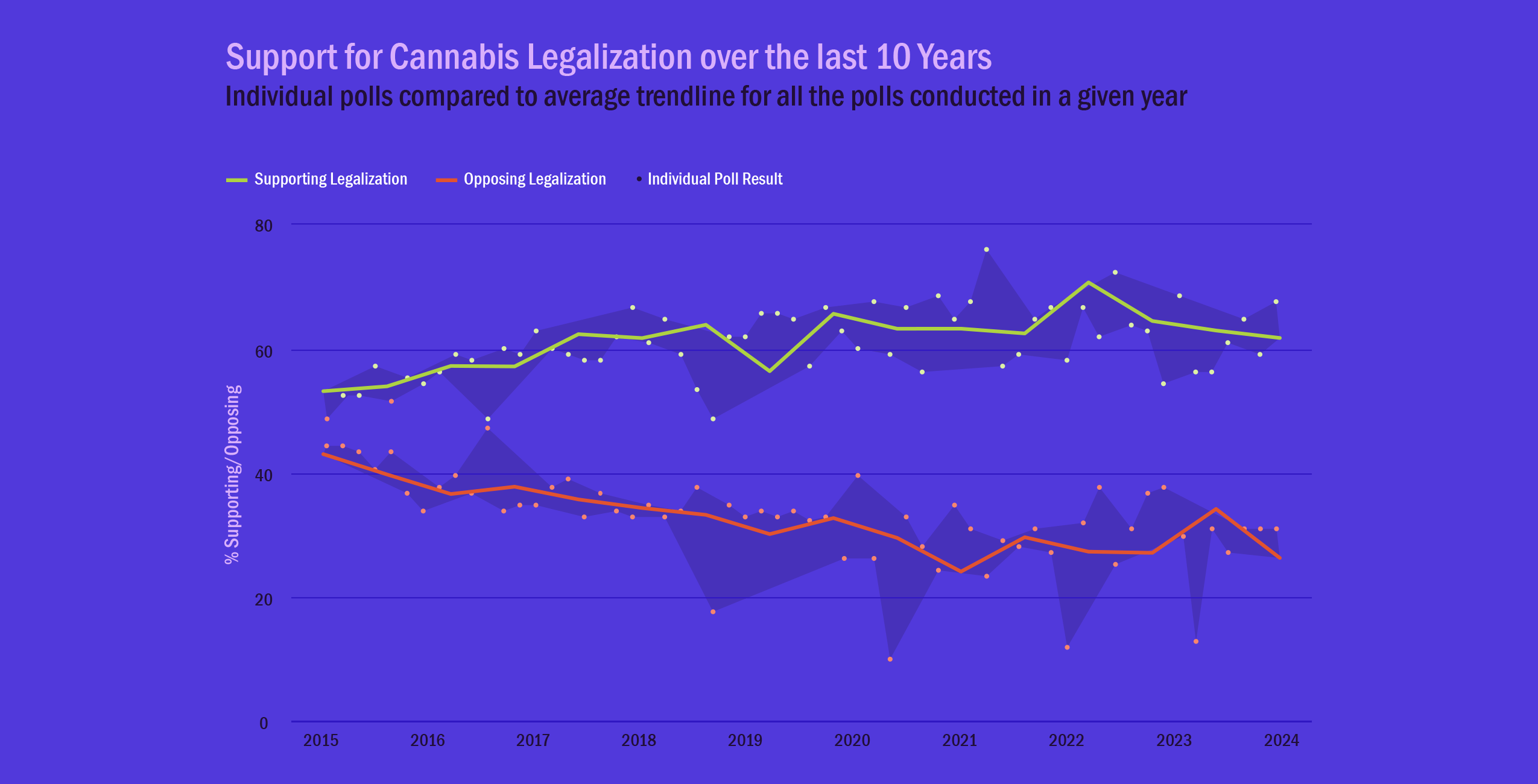
In 2015, 53% of US adults support legalization, but this quickly increased, breaking past three-fifths support in the second half of 2017 (62% support) and reaching a peak of 71% support in the first half of 2022. While support declined slightly after this high-point, it still stood at 62% in the first half of 2024.
Firstly, this is a robust demonstration of something we’ve known for some time: the majority of Americans support legalizing cannabis. However, it also suggests that there may be a decline in support in the past couple of years, with early 2022 showing substantially higher support than 2023 or 2024. This was likely influenced by an SICPA/Harris Poll which found support at 78%, and clearly shows the danger in cherry-picking favorable results when looking for the answer to questions like this.
In the overall context of the results, the apparent decline in recent years doesn’t look so concerning. Prior to this, support was at 63%, and it had declined by to this point again by 2023, but the overall trend over the decade is of increasing support. In addition, the number opposed to legalization remains very low even in 2024, with only 26% against the idea, leaving 12% undecided.
Democrats, Independents and Younger Adults Are More Likely to Support Legal Weed
CBD Oracle also looked at how the results varied based on demographic and other subgroups. While most of these analyses showed no difference, two are worth mentioning.
Perhaps expectedly, political affiliation was a big factor in support for legal cannabis. Based on polls conducted in 2024, 71% of democrats favor legalization, compared to 64% of independents and 48% of republicans. Although republicans are predictably the least supportive, it’s notable that the split is close to 50-50, and it’s possible there will be majority support among republicans in the next few years.
The other major difference was with age. Two-thirds (66%) of adults aged under 45 supported legalization, compared to 60% support among those aged over 45. Here, it’s important to note that both groups supported legalization overall.
Will Florida and South Dakota’s Upcoming Ballot Initiatives Pass?
While there are also relevant ballot initiatives in Nebraska and North Dakota, the two states with upcoming votes and enough polls to analyze were Florida and South Dakota.
For Florida, polls conducted in 2023 showed around 66% of voters in favor of legalization, but the overall result for 2024 declined to 57%. This is concerning for advocates in the state, since the initiative needs 60% support to pass, but there is good news hiding in the details. The two polls conducted in June 2024 found 66 and 64% support, and with a few months of campaigning left, it’s likely that the initiative will pass and Florida will legalize weed.
For South Dakota, the news is less positive. Two polls from 2023 analyzed via Monte Carlo showed 47% support, and the only poll conducted in 2024 put support at just 41.6%. Unfortunately, unless there is a drastic change in the coming months, South Dakotans will have to wait longer to get legal cannabis.
Conclusion: Support for Legal Cannabis Remains High, Despite Recent Declines
CBD Oracle’s analysis shows that support for legal cannabis remains high among Americans, and casts doubt on the relevance of recent declines in support. With a consistent trend towards increasing support and opposition to marijuana legalization remaining low, the data shows that the new “norm” is over three-fifths of Americans supporting legal weed. Individual polls may buck this trend, combining the polling helps you see the overall picture without being misled by individual results.
The tide has already turned; support for legal cannabis is here to stay.
You can access the full report here (PDF).
Member Blog: Understanding Michigan’s Booming Pre-Roll Market and Cannabis Testing Requirements

There is no hotter pre roll market in the country than Michigan.
With an average unit price of $6.16 – one of the lowest in the country, according to cannabis analytics firm Headset – retailers have sold more than 56.7 million units for a total of more than $349.8 million through the first seven months of 2024. That puts the state of Michigan in the top spot for pre-roll units sold and second place – to much larger California – in pre-roll revenue.
And sales are actually accelerating, with Michigan posting record high pre-roll sales numbers of nearly $54.9 million in July 2024.
But if you want to compete in the Great Lakes State’s exciting and expanding marketplace, you are going to need to make sure you understand and follow Michigan’s cannabis testing program.
In Michigan, state law requires all “raw plant material” be tested for the following:
- Moisture content and water activity;
- Residual pesticides and chemicals;
These tests are primarily implemented to safeguard consumers from hidden risks in cannabis products.
“Laboratory testing minimizes the risk of exposure to pesticides, microbes, heavy metals, molds, and residual solvents by providing consumers with information about the products they are purchasing and helps to prevent consumption by sensitive populations,” reads the “Sampling and Testing Technical Guidance for Marijuana Products” document created by the state’s Cannabis Regulatory Agency.
For example, moisture content and water activity measurements are indicators of potential mold growth. When water activity exceeds 0.70 Aw, it creates an environment conducive to mold development, which can be detrimental if ingested. This is why Michigan, like many other states, has set a maximum water activity limit of 0.65 Aw for flower and pre-rolls.
Heavy Metals Testing in Michigan
Heavy metals are absorbed through a plant’s roots and can damage all of the body’s vital systems, including the respiratory system, the central nervous system and the reproductive system, even in small doses. That’s why Michigan, like all states, requires products to pass strict heavy metals testing.
But where most states limit testing to the “Big Four” heavy metals of mercury, cadmium, lead and arsenic, Michigan goes a step farther, joining a handful of states that require testing for chromium and even adding nickel to the list as well.
Microbials and Mycotoxins
Though certainly dangerous, heavy metals are less of a threat to human health than microbials and mycotoxins.
Michigan requires testing for standard microbials like yeast, mold, E. coli and salmonella, as well as Aspergillus flavus, fumigatus, niger and terreus.
As for mycotoxins, toxic compounds produced by molds, such as Aspergillus, can suppress the immune system and cause liver damage, so testing for them is certainly a health and safety issue. Michigan law requires testing for Aflatoxin B1, Aflatoxin B2, Aflatoxin G1, Aflatoxin G2 and Ochratoxin A, requiring all to be less than 20 parts per billion to receive a passing grade.
Pesticides and residual chemicals
Michigan allows the use of some pesticides and other chemicals on cannabis, but only those appearing on the Michigan Marijuana Pesticide List, which was updated in early 2024. Pesticides on that list have been reviewed for use by the Michigan Department of Agriculture and Rural Development (MDARD) and may be used in accordance with the label instructions.
For testing purposes, state law requires labs check cannabis for 58 different residual chemicals, each with their own action limits.
Keeping your pre-rolls in compliance
Michigan regulations require tests be conducted in the product’s “final form,” though that applies to the flower itself, according to an email from the Cannabis Regulatory Agency.
“If the pre-rolls were tested as flower, that would be considered final form testing unless something was added to materially change the product,” they wrote.
But with so much time and effort spent ensuring your cannabis stays in compliance with state regulations, why would you want to pack it into pre-rolled cones that haven’t also been tested?
To ensure your cannabis stays clean, only use pre rolled cones that that have also been tested for microbials, pesticides and heavy metals. Medical patients in particular need to be careful to ensure that the paper in their pre-rolls isn’tgoing to make them sick, whether they buy them at a dispensary or pack pre-rolls at home.
In fact, a study from California’s SC labs found that 11% of rolling papers they tested would fail that state’s testing regiment, which doesn’t even include Chromium, and that 90% of rolling papers contained heavy metals with more than 8% containing them at a rate above the allowable limits.
In fact, this year, a team of researchers from Michigan this year tested 53 commercially available pre rolled cones and rolling papers and found varying levels of heavy metals throughout the samples, many of which would have caused failures if included in testing.
“Even if testing is not required, any one issue can harm your brand,” says Custom Cones USA Compliance Manager André Bayard. “It’s important to make sure you work with a company that is as focused on keeping your products in compliance as you are.”
Bayard always recommends confirming your pre-roll supplier has COAs available to prove their products are clean and will pass tests, or will send you samples for you to test before committing to a full order.
“Make sure your supplier is focused on those requirements and is trying to set the industry standard with their products,” Bayard says.
Join Us for More Exclusive Insights on the Michigan Marketplace
Striving to stay informed about Michigan’s dynamic cannabis industry? Mark your calendars for our upcoming Michigan Stakeholder Summit being held in Detroit, MI on Thursday, September 12th.
At the Michigan Stakeholder Summit 2024 you’ll be able to dive deep into the latest trends, regulations, and opportunities shaping Michigan’s cannabis landscape, including hearing directly from Brian Hanna, Executive Director of Michigan’s Cannabis Regulatory Agency. All industry professionals are invited; NCIA members attend free. Register here to secure your spot.
Member Blog: The Importance of Job Descriptions in the Cannabis Industry

As the cannabis industry continues to grow, businesses face unique challenges, particularly in Human Resources. One critical, yet often overlooked aspect, is the creation and maintenance of clear, effective job descriptions. At Deliberate HR, we understand the well-crafted job descriptions are more than just a formality- they are essential tools for success in the cannabis sector.
Why are job descriptions so important?
-
Defining Roles and Responsibilities
Job descriptions provide clarity by defining the specific roles and responsibilities of each position. In an industry as dynamic as cannabis, where job roles can vary widely- from cultivation to sales to compliance- clear definitions help employees understand their duties and how they contribute to the organization’s goals.
-
Attracting the Right Talent
In a competitive job market, a well-written job description can be the difference between attracting top talent and struggling to fill positions. A precise and appealing job description helps potential candidates understand the role and align their skills with the company’s needs, making the recruiting process more efficient and effective.
-
Ensuring Compliance and Legal Protection
Given the complex regulatory environment in the cannabis industry, job descriptions play a crucial role in compliance. They ensure that roles are aligned with the industry regulations, including safety standards and legal requirements. Additionally, job descriptions can serve as legal documentation, protecting the company in cases of disputes related to employee duties or performance.
-
Enhancing Employee Engagement and Retention
When employees understand their role and how it fits into the larger company mission, they are more likely to feel engaged and motivated. Job descriptions that clearly outline growth opportunities within the company can also boot retention, as employees see a clear path for advancement.
-
Supporting Organizational Structure and Growth
As cannabis businesses expand, job descriptions help maintain an organized structure. They ensure that each role is defined and aligned with the company’s strategic objectives, facilitating smoother scaling and growth. This is especially important in a fast-evolving industry where companies need to adapt quickly.
At Deliberate HR, we recommend that cannabis businesses approach job descriptions with intention and precision. Here are a few tips:
- Be specific and clearly define the duties, responsibilities, and expectations for each role.
- Specify the qualifications needed, including industry-specific knowledge, licenses, or certifications.
- Address any legal or regulatory responsibilities associated with the role.
- Regularly review and update job descriptions to reflect changes in the role or industry.
Job descriptions are more than just a hiring tool- they are a strategic asset that can drive success in the cannabis industry. By clearly defining roles, ensuring compliance, and aligning employee expectations with company goals, well-crafted job descriptions are a cornerstone of effective HR Management.
Member Blog: Cannabis Risk in Distribution – Navigating the Road of Theft, Auto, and More

Welcome back to the unfolding chapters of our Cannabis Risk Management series. In our preceding blogs, we intricately explored the risks woven into cultivation and the dynamic challenges faced by the retail sector. Now, our compass directs us towards the distribution sector, where the landscape extends far beyond the boundaries of a single location.
The Mobile Risks of Cannabis Distribution
At the beating heart of the cannabis industry, distribution orchestrates the seamless movement of products from cultivators to consumers. However, this fluidity introduces unique risks, with theft and auto incidents assuming prominence in the dynamic narrative.
-
Theft in Motion: A Growing Threat on the Move
Unlike the static nature of cultivation and retail spaces, the distribution sector is marked by constant motion. The mobility of distribution vehicles renders them susceptible to theft, both in transit and during stops. The repercussions extend beyond the immediate loss of inventory, amplifying the financial impact. Navigating this evolving threat demands heightened vigilance and strategic risk mitigation.
-
Auto Incidents: The Road Ahead is Paved with Risks
Transporting cannabis products along the highways introduces inherent risks of auto incidents. From road accidents causing damage to products and vehicles to potential liabilities, the road ahead is fraught with financial pitfalls. To safeguard the integrity of the distribution network, a comprehensive insurance policy specifically tailored to cover auto incidents becomes indispensable.
Mitigating Risks in Cannabis Distribution
-
Strategic Route Planning: Mapping the Path to Security
In the dynamic landscape of distribution, strategic route planning emerges as a linchpin in theft prevention. Evading high-crime areas, implementing secure parking protocols, and leveraging technology for real-time tracking are suggested ways to build a robust risk mitigation strategy. By fortifying the journey from cultivator to consumer, strategic route planning becomes a proactive defense against evolving threats.
-
Property in Transit Coverage: Protecting Cargo on the Move
A vital aspect of safeguarding cannabis inventory is ensuring robust property in transit coverage. This specific coverage protects the cannabis products while they are on the road, addressing potential losses due to theft, accidents, or other transit-related incidents. Implementing this coverage can significantly reduce the fiscal impact of such events.
-
Advanced Fleet Management for Safety: Beyond the Roads
Elevating the safety and security of distribution vehicles involves investing in advanced fleet management systems. Real-time tracking, continuous monitoring of driver behavior, and implementation of preventive maintenance measures collectively reduce the risk of both auto incidents and theft. This holistic approach not only protects the products but also ensures the well-being of the team steering the distribution network.
-
Employee Training for Security: Empowering the Frontline
Empowering the distribution team with comprehensive training in security protocols and emergency response measures is foundational. A well-trained team becomes an invaluable asset, making a significant difference in minimizing the impact of theft or auto incidents on business operations. Their heightened awareness and proactive response contribute to a secure and resilient distribution process.
Tailored Insurance Solutions for Distribution
As in cultivation and retail, standard insurance policies may fall short in addressing the evolving risks faced by cannabis distribution. Collaborating with an insurance advisor specializing in cannabis is not merely advisable; it is imperative. Tailored policies comprehensively covering theft, auto incidents, and other challenges unique to the distribution sector provide a robust safety net for operations.
As we embark on the next leg of our journey into the world of cannabis manufacturing, unraveling diverse risks related to work comp, fire, spoilage, humidity, smoke, and equipment breakdown, join us in this quest for knowledge and empowerment. Our mission is to equip you with unparalleled insights and insurance solutions, fostering sustained success in the ever-evolving landscape of the cannabis industry.
For more information, please reach out to Valerie Taylor, Vice President (National Cannabis Practice Leader), Liberty Company Insurance Brokers.
Committee Blog: The Benefits of Intrusion Systems in Cannabis Retail – Ensuring Security and Compliance

The cannabis industry has seen tremendous growth in recent years, with more and more states legalizing its use for medical or recreational purposes. With this expansion comes a need for comprehensive security solutions to protect businesses from potential threats. While they are just one component in a comprehensive security strategy, intrusion systems play a crucial role in ensuring the safety of employees, customers, products and cash for cannabis retailers.
In this blog post, we’ll dive into the benefits intrusion systems specifically tailored for cannabis industry retailers and consultants – and what a full-service security provider like Vector Security, which offers a dedicated cannabis team of experts – can provide when it comes to protecting your business.
Enhanced Security
One of the primary reasons why intrusion systems are essential in cannabis retail is their ability to enhance overall security. By monitoring and detecting intrusion, these systems prevent unauthorized entry into sensitive areas such as stock rooms, storage areas, cash registers and safes, and computer/networking equipment and devices. This level of control significantly reduces the risk of break-ins, internal and external theft, vandalism and other criminal activities by limiting access to authorized personnel only.
Immediate Alerts
Intrusion systems are equipped with advanced technology that can detect unauthorized entry or tampering with security equipment. Motion detectors, glass-break and door/window sensors trigger visual and audible alarms to ward off intruders, while providing real-time alerts to store owners and other stakeholders as well as alarm monitoring operators. If the emergency is real, authorities are dispatched to the location of the intrusion. This swift response time is crucial in preventing further damage or loss. Professionally monitored intrusion systems ensure your cannabis facility is protected around the clock – during and after business hours, and even on holidays.
Compliance with Regulations
Operating within the cannabis industry means complying with strict regulatory frameworks that can vary from state to state. These regulations often include guidelines related to security and surveillance. Intrusion systems are a vital component in meeting these requirements. By maintaining accurate records of security incidents, cannabis retailers can demonstrate their commitment to compliance during audits. Here is where a seasoned security provider, like Vector Security, can advise and design a system that complies with regulatory requirements.
Protection of High-Value Products
Cannabis products have significant value, making them attractive targets for criminals. Whether it’s the actual flower, edibles or concentrates, protecting these assets is crucial for a successful business. Intrusion systems help safeguard inventory, reducing the risk of internal and external theft and ensuring product availability for legitimate customers.
Cash Management
Cash remains a primary form of payment in many cannabis dispensaries. This makes retailers vulnerable to theft and robberies. In areas where cash is kept, intrusion systems can provide an added layer of security by securing cash registers, safes and other cash-handling areas.
Panic Alarms
In addition to detecting unauthorized entries, modern intrusion systems often include panic alarms. These alarms allow employees to quickly signal for help in emergency situations. Whether it’s a medical issue, a threat from a customer or any other crisis, panic alarms provide immediate assistance. Install panic buttons around the store and in areas with cash so employees can safely and discreetly summon authorities in the event of an emergency, like during a burglary or hold-up robbery.
Scalability
As the cannabis retail industry continues to expand, scalability becomes crucial. An initial investment in a comprehensive and flexible security solution ensures that the system can grow along with your business. Whether opening additional stores or cultivation facilities, retailers should be able to seamlessly integrate new locations into their existing security infrastructure. Make sure your security provider can adapt your security solution to respond to your business’s changing needs, including responding to new threats or opportunities.
Conclusion
Intrusion systems are not only about preventing break-ins, they are also essential tools for maintaining compliance, protecting valuable assets, and ensuring the safety of employees and customers. By investing in robust security solutions, cannabis retailers can focus on their core business knowing that their facilities are well-protected.
Remember that while effective at providing a layer of protection, intrusion systems are just one component of a comprehensive security plan for cannabis businesses. It’s beneficial to work with a full-service security provider that can design a complete plan that integrates and streamlines all parts of your security, such as video surveillance, access control, fire and environmental monitoring, panic alarms and more. Working with a full-service vendor that has expertise in the cannabis industry ensures you’ll receive the range of products and services you need, with tailored solutions that meet the unique demands of your cannabis business.
Committee Blog: Breaking the Stigma – Cannabis in the Retail World

Published on behalf of members of NCIA’s Retail Committee
Cannabis, once relegated to the shadows of society, is making a significant push into mainstream America. However, the journey from prohibition to acceptance is faced with many challenges, particularly in the retail world. The stigma surrounding cannabis stems from historical, legal, social, and cultural factors, and lack of education, plays a role in shaping the stigma. In this blog, we’ll explore some of the roots of the stigma on cannabis and how the landscape is gradually changing.
The Historical Backdrop
The roots of cannabis stigma are deeply embedded in history. In the early 20th century, cannabis was criminalized in many parts of the world. The United States’ War on Drugs, which began in the 1970s, heavily penalized cannabis use, linking it to criminal behavior and societal decay. Media reports of cannabis users as lazy, unmotivated, or criminals; these negative stereotypes are what many believe to be true.
However, alongside this negative portrayal, there exists a rich history of cannabis as a medicinal plant. For centuries, cannabis has been used to treat a variety of medical issues. Ancient cultures across Asia, the Middle East, and Africa utilized cannabis for its therapeutic properties, including pain relief and anti-inflammatory benefits.
In more recent times, cannabis has shown promise in helping cancer patients manage symptoms such as nausea, pain, and loss of appetite. Additionally, it has been found to fight inflammation, which is beneficial in treating conditions like arthritis and multiple sclerosis. This positive history of cannabis as a healing plant is often overshadowed by its criminalization and the stigma attached to its recreational use.
Legal and Regulatory Hurdles
One of the most significant barriers to cannabis acceptance in retail is the complex legal landscape. In the United States, for instance, cannabis remains illegal at the federal level, despite being legal in several different states. This legal ambiguity creates uncertainty and fear among businesses, banks, customers as well as B2B consumers.
Moreover, the reluctance of banks and financial institutions to work with cannabis-related businesses due to federal regulations results in limited access to financial services and funding. This financial exclusion makes it difficult for cannabis businesses to operate and expand, perpetuating the stigma. It also makes it challenging for funding purposes for these businesses to continue to operate efficiently.
Social and Cultural Challenges
Public perception plays a crucial role in the acceptance of cannabis. Despite increasing acceptance, many still view cannabis use negatively and as a Schedule 1 drug, influenced by concerns about health impacts, addiction, and moral values. Workplace policies that maintain strict no-drug stances, regardless of legal status, also contribute to this negative perception. Enhancing education on cannabis can help mitigate this stigma within our culture, which in turn will aid in positioning the cannabis industry as a credible sector in the eyes of consumers, banks, and other business sources.
Retail Industry-Specific Issues
In addition, mainstream retailers are often hesitant to carry cannabis products due to fear of backlash from conservative customers or communities, which limits the visibility and availability of these products in the broader spectrum.
Furthermore, stringent marketing and advertising regulations restrict cannabis businesses from effectively reaching new customers and normalizing their products. Social Media advertising is prohibited as well as certain television channels.
Conclusion
Resolving the challenges surrounding the stigma of cannabis in the retail world requires a multifaceted approach. Firstly, education plays a pivotal role: increasing public awareness about the medicinal benefits of cannabis and dispelling myths through targeted campaigns can shift negative perceptions. Secondly, advocating for legislative reform to align federal and state laws can provide clarity and confidence for businesses to operate effectively. Moreover, fostering open dialogue among stakeholders, including policymakers, industry leaders, and the public, can promote understanding and acceptance. Lastly, mainstream retailers can be encouraged to embrace cannabis products through initiatives that demonstrate responsible consumption and highlight regulatory compliance, thereby normalizing its presence in the retail market. By addressing these aspects comprehensively, we can gradually reduce stigma and integrate cannabis as a legitimate and beneficial sector within the retail market.
Member Blog: The Science of Smokeability

While there’s a lot more science involved in the cannabis industry today than back when folks were growing in closets or on hidden hillsides, none of that science has focused on the end user.
We know how to increase yield and cannabinoid production, for example, but there hasn’t been any real research done on how cultivation techniques or delivery methods affect the smokeability of the product from the consumer standpoint.
Until now, that is.
The cannabis industry is entering a new era of scientific rigor and consumer-focused research with the launch of a groundbreaking study called The Science of Smokeability (SOS). This multi-year research project, spearheaded by Custom Cones USA and the DaySavers brand in partnership with the Cannabis Research Coalition and The Network of Applied Pharmacognosy (NAP), aims to revolutionize our understanding of cannabis cultivation, processing and consumption.
Unlike previous research that primarily focused on things like cannabinoid percentages, the SOS study seeks to establish clear links between cultivation and manufacturing practices and the end-user experience. By doing so, it has the potential to transform product quality, consistency and safety across the industry.
A Comprehensive Approach
One of the most innovative aspects of the SOS study is its comprehensive approach. It combines controlled laboratory experiments with consumer research, creating a holistic view of the smoking experience. This methodology allows researchers to analyze various factors that influence cannabis quality, including mineral content, nutritional content (flushing), nitrosamines (potential carcinogens), moisture content, and their effects on ash color, smoke composition, and overall smoke quality.

On the lab side, the SOS will be led by conducted by qualified researchers from various organizations including The Cannabis Research Coalition (CRC), an academic cultivation research group that is developing advanced cultivation techniques aimed at optimizing yield and quality of medicinal cannabis, and The Network of Applied Pharmacognosy (NAP), a nonprofit organization focusing on providing quality cannabis materials and tracking the experience of users.
Dr. Allison Justice and Dr. Markus Roggen, two of the top researchers on the study are previously known for their groundbreaking work in exploring the color change of ash in cannabis smoking. The SOS study has also partnered with Controlled Chemistry, experts in cannabis smoke and inhalation studies for cannabis, leveraging cutting-edge technologies and methodologies.
“This cross-departmental research collaboration extends beyond mere acquisition of sustainable and profitable cultivation and post-harvest metrics; we are actively establishing the benchmarks for ensuring the highest standards in producing flower intended for combustion” said Justice, founder of the Cannabis Research Coalition.
To gain consumer insight, DaySavers will be paying 200 lucky people, drawn at random, to receive and smoke two pre-rolls and then provide feedback on the experience. That data will be combined with the lab work to create the final reports.
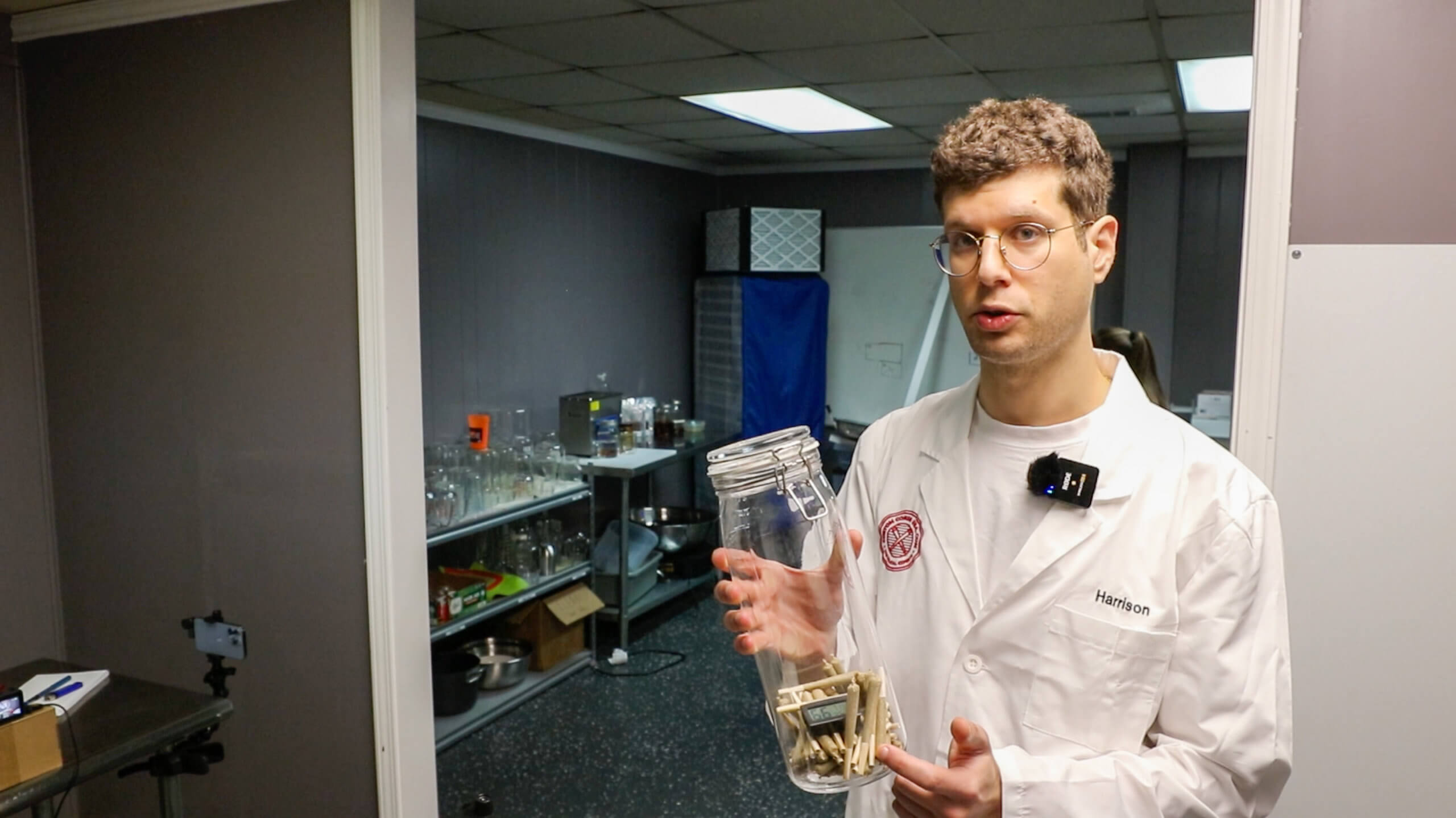
This unique and consumer-centric approach and focus on “smokeability” aligns with the industry’s growing focus on end-user satisfaction and, we hope, could lead to products that better meet consumer preferences.
Developing Standards
The first phase of findings is expected to be published in the coming months and will demonstrate how to optimize cultivation metrics to save time, money and resources while enhancing product quality.
The study will also include experiments on infused pre-rolls, testing different infusion processes and their effects on temperature and cannabinoid/terpene delivery.
We think the implications of this research for the cannabis industry will be far-reaching. By understanding how different cultivation and processing variables affect the final product, growers and manufacturers can fine-tune their practices to create superior cannabis products. This could lead to more consistent, higher-quality pre-rolls and other cannabis products in the market.
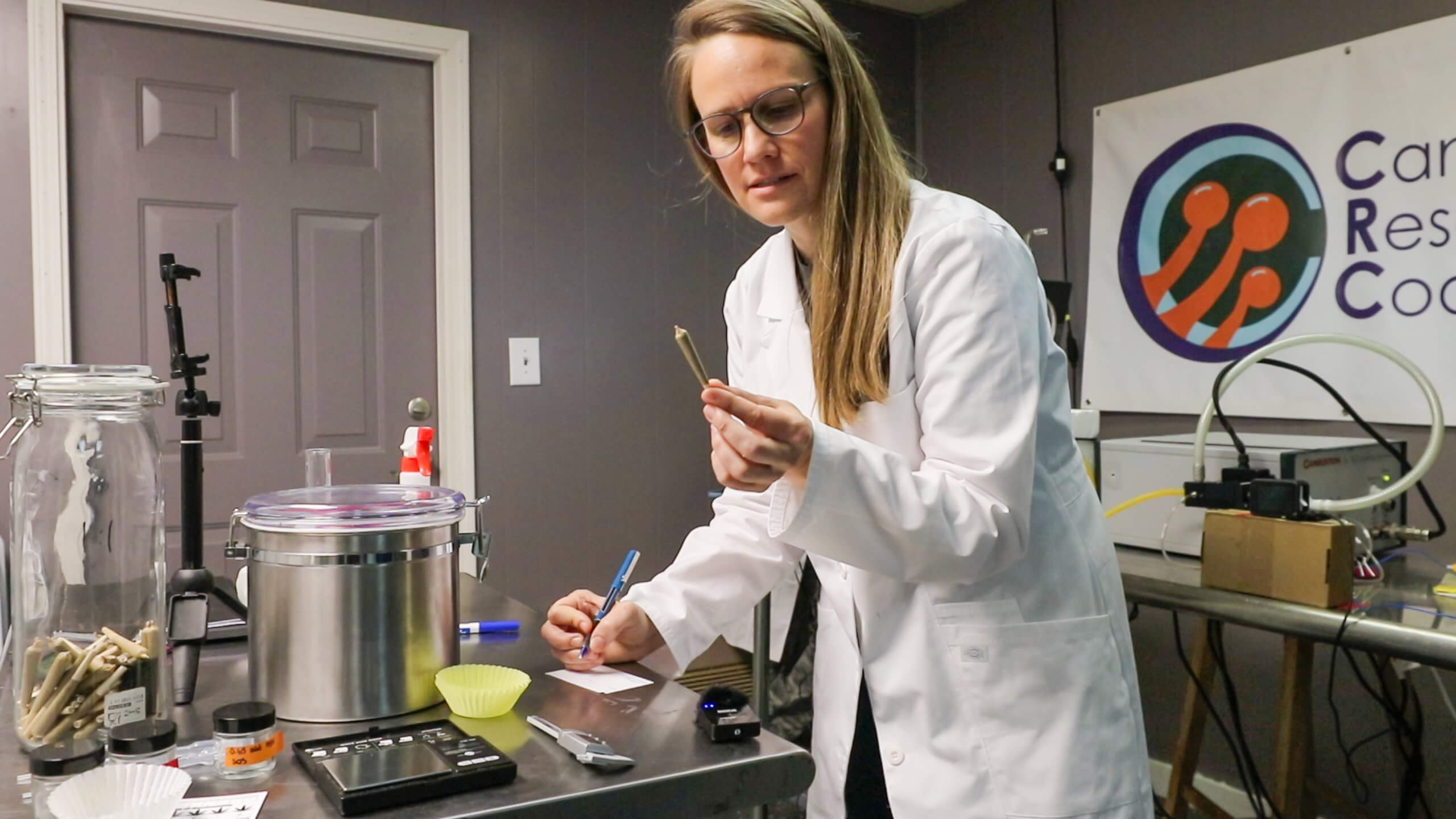
The findings from the SOS study will also be shared with ASTM International, an organization that establishes industry standards. The hope is that it leads to the development of new benchmarks for quality and safety in cannabis cultivation and product manufacturing. Moreover, by providing solid scientific data on cannabis smoke composition and quality, the study could influence cannabis policy decisions. This is particularly significant for states that are hesitant to permit smokable flower due to uncertainties about the substances produced in cannabis smoke.
For cultivators, the study could provide valuable insights into optimizing their growing techniques for better quality. Manufacturers could use the findings to improve their processing methods and create more appealing products. Retailers and budtenders could leverage the research to provide more informed recommendations to consumers.
Plus, the study’s focus on safety and quality could help address concerns about the health impacts of cannabis smoking. By identifying factors that contribute to a “safer” smoking experience, the industry could potentially mitigate some of the health risks associated with cannabis use.
At Custom Cones USA and DaySavers, we’re known for our commitment to transparency and the rigorous testing of our pre-rolled cones, as well as other products like blunt cones and the Smoke Temple Cross Cone, for pesticides, heavy metals and microbials. We do this, despite it not being required, because we believe it makes a better, safer final product for the end user. Our hope is that by focusing this study on “smokeability,” others in the industry will put the consumer first as well.
A New Kind of Study
The Science of Smokeability study marks a pivotal moment in the evolution of the cannabis industry. As the cannabis market continues to mature and evolve, research like the SOS study will be crucial in establishing cannabis as a legitimate, well-understood, and responsibly produced consumer product.
By bringing together scientific rigor, consumer experience and industry expertise, it has the potential to drive innovation, improve product quality, shape the future of cannabis cultivation and consumption.
The SOS promises to enhance our scientific understanding of cannabis as both a medicinal and recreational product, potentially revolutionizing how we approach cannabis cultivation, processing and consumption in the years to come.
And we’re excited to be a part of it.
Member Blog: Financial Services Survey – Seeking Licensed Cannabis Operators to Participate

As public opinion shifts and state and federal policies on cannabis continue to evolve, more banks and credit unions are venturing into this market. With competition intensifying, financial institutions must offer products and services that meet the changing needs of the industry.
Shield Compliance, a leading compliance platform for cannabis banking, is conducting a survey of licensed cannabis operators regarding their satisfaction with the banking partners, products, and services available to them. The survey allows licensed operators to offer valuable insights and shape financial institutions’ services going forward.
Shield welcomes all licensed cannabis operators to participate. The survey consists of short, multiple-choice questions and should only take about ten minutes to complete. You may answer the survey anonymously, or you may provide your contact information to be entered to win an Amazon gift card worth $200.
To participate in the survey, please click here or copy and paste it into your browser. Additionally, we encourage you to share this survey link with other cannabis operators within your network who may be interested in contributing to this study. The more diverse responses we receive, the more comprehensive our findings will be.
The survey will be available until August 9th.
Thank you for your participation.
Member Blog: CBD When Pregnant

Disclaimer: The content in this blog is for informational or educational purposes only and does not substitute professional medical advice or consultations with healthcare professionals.
If you’re pregnant or trying to conceive, you may have heard of the potential benefits of CBD during pregnancy. Alternatively, you may already take CBD oil regularly and are unsure whether you should continue. Here, the team at Goodray’s explores the latest information around CBD in pregnancy and whether it is a safe supplement during this time.
What is CBD?
Cannabidiol, or CBD, is a natural compound found in the cannabis plant. Unlike tetrahydrocannabinol (THC), CBD does not produce a high or any level of intoxication. CBD has become known for its therapeutic benefits, which include reducing anxiety and improving sleep. With these benefits, it’s clear why you might consider using it during pregnancy. However, it is crucial to understand the research around CBD before making a decision.
Is CBD Safe to Use During Pregnancy?
Currently, there is not enough research on CBD in pregnancy to determine whether it is a safe supplement. While research shows that CBD may have potential benefits for a range of medical conditions, its effects on fetal development and pregnancy are unknown.
Many healthcare professionals advise against using CBD during pregnancy due to this lack of research. If you are considering using CBD for the first time or continuing to use it, you should speak directly with your healthcare team. This allows you to make an informed decision based on your individual circumstances.
Potential Benefits of CBD During Pregnancy
CBD oil has many therapeutic benefits, particularly in stress and anxiety relief. During pregnancy, some mothers-to-be may experience heightened levels of anxiety and stress. CBD oil has the potential to treat anxiety and promote relaxation during this time.
Additionally, sleep issues are common during pregnancy, and CBD oil may help improve sleep quality. Some expectant mothers may find it difficult to get a good night’s sleep due to discomfort or hormonal changes. CBD’s calming properties might offer some relief and better sleep.
Despite these potential benefits, it’s important to remember that the research supporting the use of CBD during pregnancy is not yet available. Therefore, it is crucial to be mindful and consider whether it is the best choice for you.
Potential Risks of CBD During Pregnancy
Much like the benefits, the risks of using CBD during pregnancy are largely unknown. While there is no research to suggest that CBD causes any problems, there is also no research to the contrary. Some health professionals argue that CBD could potentially interact with other medications or supplements required during pregnancy, impacting fetal development.
Moreover, the quality and purity of CBD products can vary significantly. If not sourced from reputable places, CBD products can contain other substances, including THC or other cannabinoids, which you would not want to ingest while pregnant. Ensuring you source pure CBD oil should be a priority if you choose to use it.
Understanding the Research and Expert Opinions
The current body of research on CBD use during pregnancy is limited, and most studies are either in early stages or conducted on animals. This makes it challenging to draw definitive conclusions about the safety and efficacy of CBD for expectant mothers.
Healthcare professionals generally take a cautious approach due to the lack of comprehensive human studies. Organizations such as the American College of Obstetricians and Gynecologists advise against the use of cannabis and its derivatives, including CBD, during pregnancy. This caution is primarily due to the potential unknowns and the precautionary principle of “first, do no harm.”
Consulting with Your Healthcare Provider
Given the uncertainties surrounding CBD use during pregnancy, it’s essential to consult with your healthcare provider. Your doctor can provide personalized advice based on your health history and current condition. They can also help monitor any potential interactions with other medications you may be taking.
If you and your healthcare provider decide that using CBD is appropriate, it’s crucial to source high-quality products from reputable suppliers. Look for products that have been third-party tested for purity and potency. Avoid products with additives, contaminants, or THC.
Alternatives to CBD for Managing Pregnancy Symptoms
If you are looking for natural ways to manage anxiety, stress, or sleep issues during pregnancy, there are several alternatives to consider:
- Exercise: Regular physical activity, such as walking, swimming, or prenatal yoga, can help reduce stress and improve sleep.
- Mindfulness and Meditation: Practices like mindfulness, meditation, and deep breathing exercises can promote relaxation and reduce anxiety.
- Diet and Nutrition: Eating a balanced diet rich in essential nutrients can support overall well-being and help manage stress.
- Herbal Teas: Some herbal teas, such as chamomile, can promote relaxation and improve sleep. However, always consult with your healthcare provider before trying new herbal remedies.
- Support Networks: Building a support network of family, friends, or support groups can provide emotional support and reduce feelings of isolation.
Final Thoughts
CBD oil is a natural product with potential therapeutic benefits, but whether you choose to take it during pregnancy is a personal decision. Given the lack of substantial research, it is essential to weigh the potential benefits against the unknown risks carefully.
Discussing your options with your healthcare team is the best way to make an informed decision that prioritizes your health and your baby’s well-being. Goodrays crafts and sells high-quality CBD oils and products designed to complement your lifestyle, free of any potentially harmful substances. However, it is crucial to ensure any CBD product you consider is sourced from a reputable provider and meets high standards of purity and quality.
In conclusion, while CBD may offer potential benefits, the safety of its use during pregnancy remains uncertain. Always prioritize open communication with your healthcare provider and make choices that align with your health needs and pregnancy journey.
Committee Blog: Understanding the Nutritional Demands of Cannabis

The nutritional demands of cannabis are still not well understood. Due to the legal status of the plant, intense studies on cannabis nutrition have been limited. The subtleties of plant nutrition are not well understood, particularly in cannabis. Nickel was not recognized as a plant essential nutrient until 2004. The presence of a single micronutrient deficiency can decrease the production of fruit and some flowers in excess up 30%.
The Presence of Physical Symptoms
The physical symptoms of plant deficiencies and toxicities typically don’t manifest from anywhere between three and nine weeks. Usually, by the time these physical symptoms appear visually, the damage has already begun to occur. Physical symptoms of plant nutrition vary considerably and there’s substantial overlap between the visual characteristics of symptoms. Nutritional deficiencies can sometimes be caused by the toxicity of another element. For example, an excess of magnesium can inhibit the plants’ ability to uptake calcium.
The Importance of Soil and Growing Media
The soil/growing media used during the cultivation process can impact nutrient absorption in several ways, primarily depending on its physical and chemical characteristics. Cannabis prefers well-draining media with a pH range of 5.8-6.2. The pH of the media itself can enhance or reduce the plants’ ability to absorb certain nutrients. For example, iron becomes decreasingly soluble at higher pH levels. The drainage of the media is highly dependent on the growing style and environment, but generally, a well-draining growing media allows for healthy roots and maximum nutrient absorption. The media acts as a sort of nutrient reservoir for the plant’s roots.
Leaf Tissue Analysis
Leaf tissue analysis has been a long-utilized tool in traditional agriculture. Its presence in cannabis is limited primarily due to the long-standing illegality of the plant. However, there has been major interest recently in using this tool in cannabis cultivation. The basic premise is that fan leaves are removed from the plant, dried to completion, and analyzed at an analytical laboratory for primary, secondary, and micronutrients. One of the main advantages of this is the guesswork is taken out of the identification of the toxicity or deficiency. Visual symptoms of toxicities and deficiencies can have overlapping visual cues. The nutritional issues may be far more complex than an issue with a single element. By having empirical data, it allows the cultivator to compare the analytical results to established target values. From there, the cultivator can adjust the fertilization program to mitigate any potential toxicities or deficiencies. Regular monitoring of nutrient levels allows for proactive adjustments of the fertilization program. This, in turn, can lead to optimization of quality and yield.
Fertilizer
Fertilization is one of the most important aspects of any cultivation. A dialed in nutrient program optimizes the speed of growth, quality of the product, and overall yields. Fertilization can be a complex puzzle and no two cultivators grow in the exact same way. By analyzing the fertilizer, nutrient solution, plant tissue, water, and growing media the cultivator can trace back to the source of any potential issue. A common issue in cannabis cultivation is iron deficiency, this can be caused by an excess of manganese as cannabis will selectively absorb manganese over iron. The iron levels may be completely sufficient in the nutrient solution, but the excess manganese mitigates absorption. A typical response to an iron deficiency would be to add more iron, by using plant tissue and nutrient data, it can be discerned that the solution to the problem is a reduction in manganese and not the addition of more iron.
Water
Water quality is one of the foundations to successful cannabis cultivation. Testing water prior to planting and throughout the growing season can help prevent issues before they occur. If the source water for the nutrient solution originates from a well, it is important to understand the mineral content of the water so that fertilization can be adjusted accordingly. If the water is filtered, it is a useful tool to monitor the life of the filters. As reverse osmosis (the most common type of filtration used in cannabis cultivation) filters age, the boron concentration in the filtered water begins to rise considerably. In addition to this, the presence of excess chlorine or chloramine can create issues with nutrient absorption.
Environmental Conditions
Environmental conditions play a significant role in nutrient absorption and overall plant health. Nutrient levels can be optimized in the fertilizer solution, but environmental effects can prevent optimized nutrient absorption. Humidity, temperature, light, CO2, etc. can all greatly impact the plants’ ability to uptake nutrients. Optimization of these conditions is critical to a successful cultivation.
Conclusion
While the nutritional demands of cannabis are still not fully understood, leaf tissue, water, soil, and fertilizer analysis can assist immensely in the identification and mitigation of nutritional deficiencies and toxicities. These tools allow cultivators to make data driven decisions and prevent issues before they occur. Optimizing nutritional levels in cannabis maximizes the quality and yield of the plants.
Make Your Comment Count! A Guide for Industry Advocates

Understanding the Importance of Effective Public Comments on Cannabis Rescheduling Proposals
The cannabis industry is abuzz with anticipation over the rescheduling proposals. From industry groups to advocacy organizations, companies, and activists, discussions on submitting effective public comments are in full swing. This marks a significant moment as the federal government proposes to reclassify cannabis for the first time, moving it from Schedule I to Schedule III. This move acknowledges cannabis’s medical value, a recognition long sought after. Amidst this pivotal moment, it’s crucial to ensure that your public comments on cannabis rescheduling are not only heard but are also meaningful and impactful.
For a comprehensive toolkit to assist in crafting your public comment, visit NCIA’s resource page here.
Tips for Crafting Effective Public Comments on Cannabis Rescheduling Proposals
1. Be Respectful
While it may seem obvious, maintaining respectful language is crucial. Emotions can run high when discussing cannabis regulation, but name-calling or using foul language can undermine your message. Ensure your comments are taken seriously by maintaining a professional tone.
2. Stay on Topic
Focus your comments narrowly on the specific cannabis rescheduling issue at hand. Whether addressing the DEA or local city council, avoid including unrelated grievances. For example, if discussing zoning laws affecting cannabis businesses, refrain from delving into tax issues or home grow regulations. This clarity strengthens your argument and prevents your message from appearing scattered.
3. Clearly State Your Requests
Ensure your asks are explicit and easy to identify. Begin and conclude your letter with a clear statement like, “I am asking you to…”, followed by the action you want. Decision-makers review numerous letters daily, so clarity on your stance and desired action is essential for your public comment on cannabis rescheduling to be counted.
4. Provide Supporting Data and Stories
Back your arguments with relevant data and compelling anecdotes. This enriches your public comment on cannabis rescheduling and provides context for your requests. Ensure your evidence supports your advocacy effectively.
The Importance of Advocacy in Cannabis Rescheduling
Public support has been instrumental in progressing cannabis rescheduling reform. However, societal attitudes towards cannabis are dynamic, and advocacy efforts are crucial in maintaining momentum. Active participation in public processes, done respectfully and productively, is our best defense against potential setbacks in cannabis policy.
Advancing Change: Advocacy Through Effective Public Comments on Cannabis Rescheduling
Crafting effective public comments on cannabis rescheduling is a vital tool in advocating for cannabis rescheduling. By following these tips, you can ensure your voice is heard in the ongoing discussions. Remember to share this guide with fellow advocates to strengthen our collective impact in shaping cannabis rescheduling policy.
Additional Resources for Reference from NCIA
Start Making Sense: What Does Schedule III & Section 280E Mean for Me?
Cannabis Rescheduling Impact on Research and Safety: Insights from NCIA Webinar
Taking the Long View – Strategic Facility Design Considerations for the Schedule III Era
HHS Recommends Rescheduling: Now What? | 9.14.23 | Fireside Chats with NCIA’s Government Relations Team
IRC Section 280E: An Unjust Burden on State-Legal Cannabis Businesses
Member Blog: Impact of Cannabis on Sleep Medication Use

Last year, Management Science Associates (MSA) partnered with Vireo Health of Minnesota to complete a first of its kind study that sought to analyze the relationship between opioid reduction and cannabis consumption (you can find more information on those findings in our previous post).
More recently, MSA has been exploring the impact of cannabis on sleep medication use. An estimated 30% of adults experience symptoms of insomnia, which can include difficulty falling asleep, staying asleep, or waking up too early. Patients with insomnia often rely on various prescription and/or over the counter sleep aids to manage their conditions, which can result in adverse effects, including the risk of abuse and cognitive impairment, especially in older adults. Fortunately, the increased acceptance of medical cannabis has resulted in many patients exploring it as a potential alternative.
Although previous studies have shed light on the impact of cannabis for insomnia, more research is needed to fully understand its potential and determine appropriate dosages and long-term effects. Using real-world data, MSA has conducted a study on patients diagnosed with insomnia to investigate the effectiveness of medical cannabis to reduce sleep medication use.
Methodology
The study included adults aged 18 and over, diagnosed with insomnia disorders based on ICD-10 codes, who have purchased cannabis products through medical cannabis dispensaries in Minnesota from 2016 to 2020. Using MSA’s patented de-identification technology, we linked each patient’s electronic health records (EHRs) with medical cannabis dispensary transaction records while protecting patient privacy.
We investigated the trends of cannabis products use in patients with insomnia, according to demographics, and quantified changes in sleep medication use over time, using the Defined Daily Dose (DDD) established by the World Health Organization (WHO) to obtain a ratio that reflects the patient’s daily medication intake in a standard measure. We analyzed the differences in medication use before and after cannabis use, and characterized the patients who experienced a reduction in sleep medication use.
Key findings included:
Demographics: The majority of insomnia patients participating in our study fall within the middle-aged bracket. Almost 50% of the participants were aged 35-50 years, closely followed by 44.4% within the 51-64 year age group.
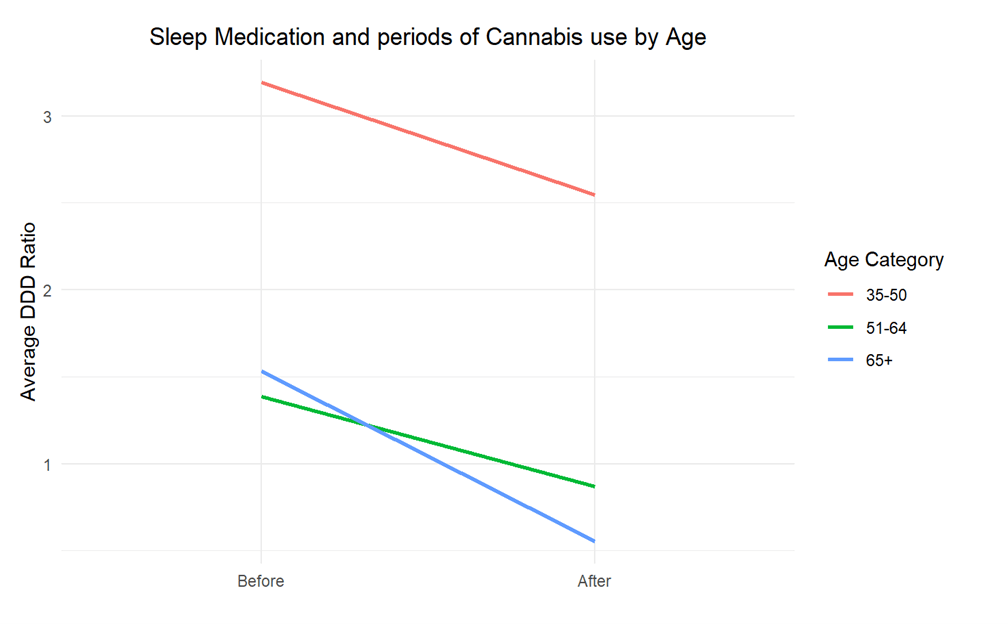
Decrease in sleep medication usage: Our results showed an overall 26.7% decrease in the defined daily dose (DDD) of sleep medications after cannabis use. Patients using cannabis experienced notable decreases in sleep medication use, with the most substantial improvements seen in individuals aged 50 and older. Specifically, those over 65 years old saw a dramatic 60% reduction. Meanwhile, the 51-64 age group benefited from a 39% reduction, and those aged 35-50 observed a 25% decrease. Patients 35-50 years old were using higher doses of Sleep medications than other age groups. Patients over 65 years old exhibited a more pronounced reduction in DDD ratios compared to other age groups. This suggests that older patients might benefit more significantly from cannabis use in terms of reducing their sleep medication intake.
Percentage Reduction of sleep medication by age category
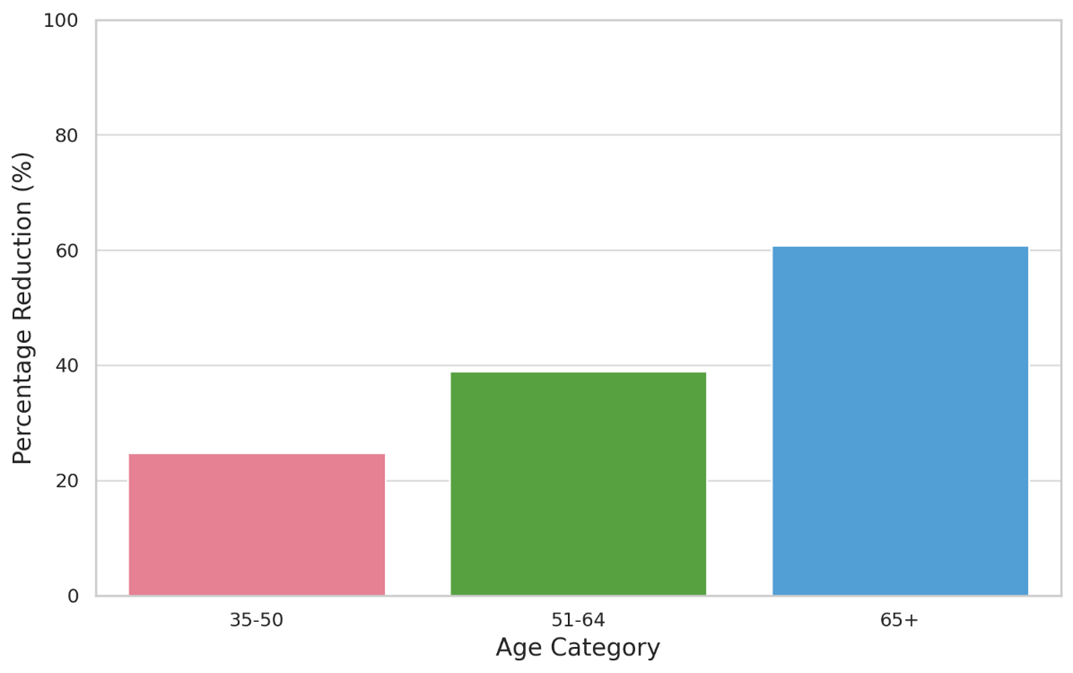
Reduction by THC:CBD ratio: Although most patients with insomnia in this study were using cannabis products with a ratio of 19:1, the THC:CBD ratios that were most effective to reduce sleep medication use were 4:1. 20:1, and 1:1.
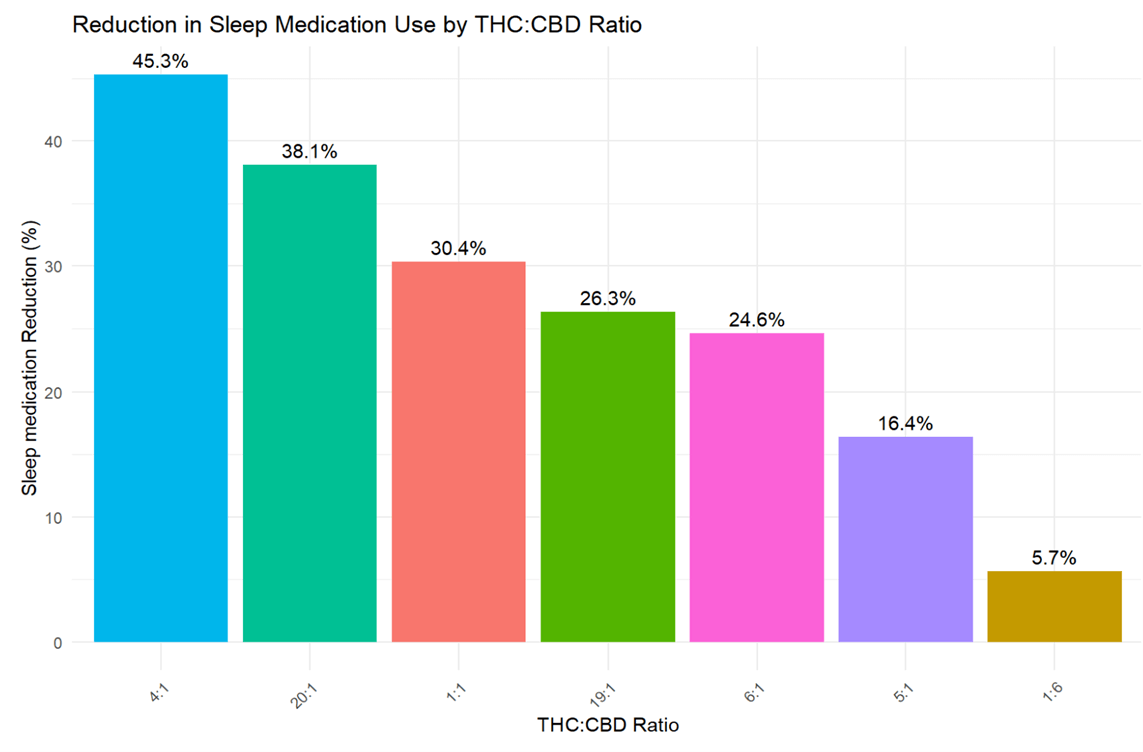
Reduction by Type of sleep medication: In our analysis, we observed a significant reduction in the use of various sleep medications among patients who began using cannabis, with benzodiazepines showing a particularly notable decrease of approximately 50% of the daily dose. The group of patients that experienced a reduction of sleep medication during cannabis use were mostly using Benzodiazepines, among which the most used were Alprazolam, Lorazepam, Diazepam, and Clonazepam.
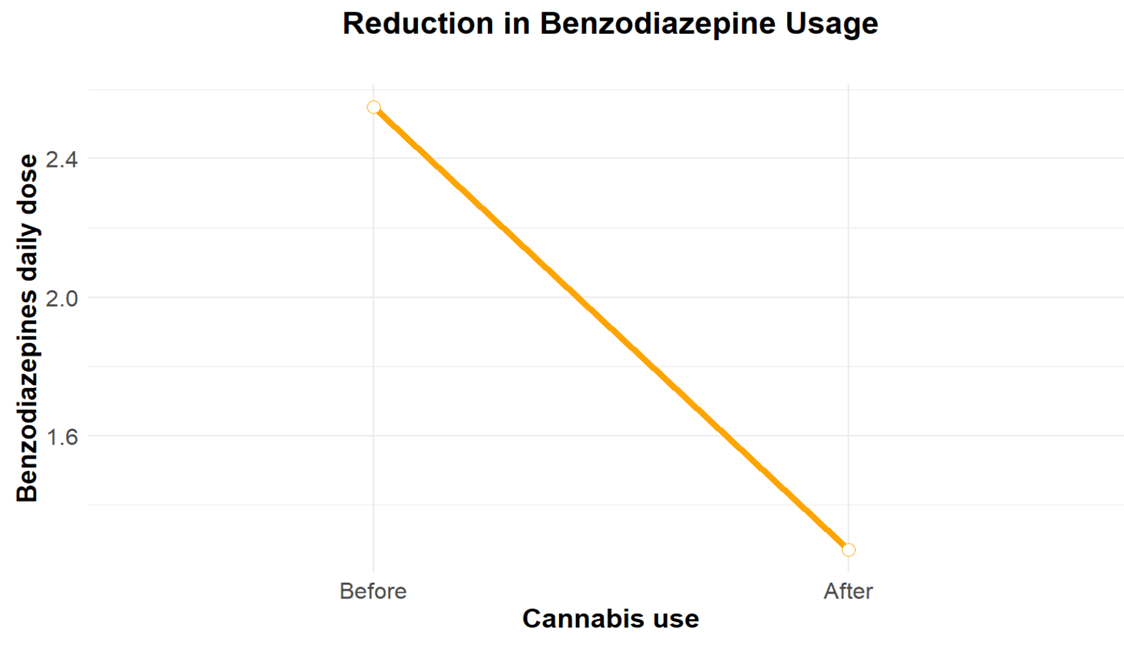
Product Form and Reduction of Sleep Medication: Patients who were using cannabis in capsules experienced the most reduction in sleep medication use. Capsules can have a high bioavailability, meaning more cannabis enters the bloodstream compared to tablets, which could make them more effective. Gummies were most used by patients using high dosages of sleep medications at baseline.
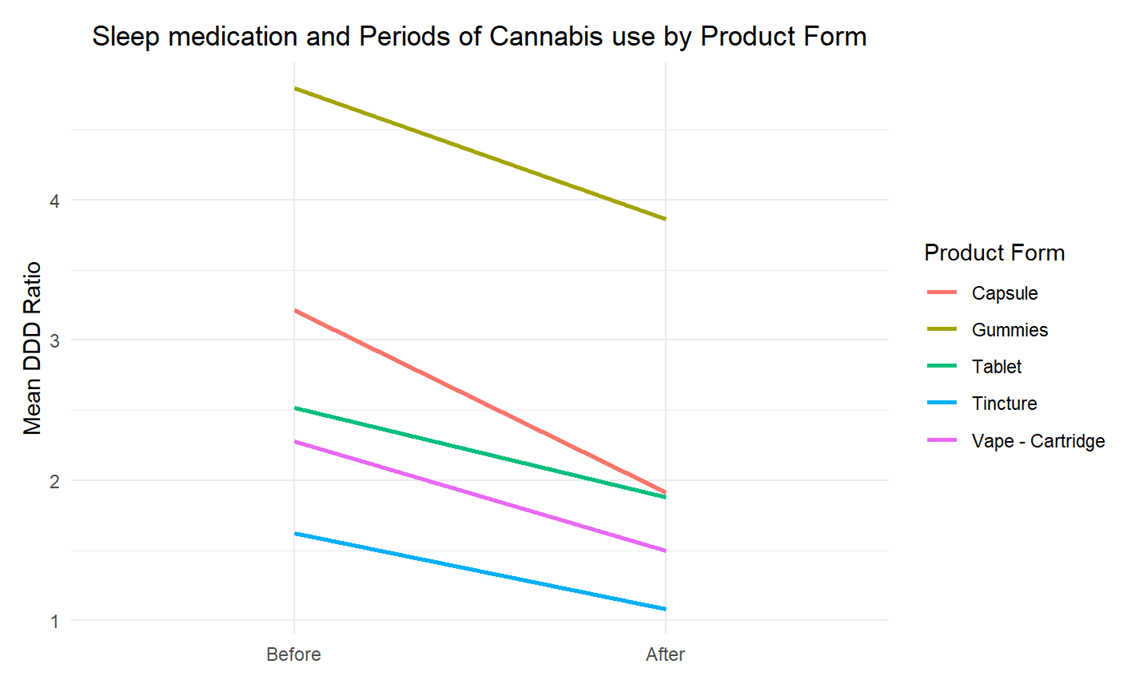
Milligrams of THC: Cannabis products with higher amount of mg of THC were corelated with higher daily dose of sleep medications. This supports previous literature about the effect of THC on insomnia, where lower contents of THC being most effective to alleviate insomnia are reported.
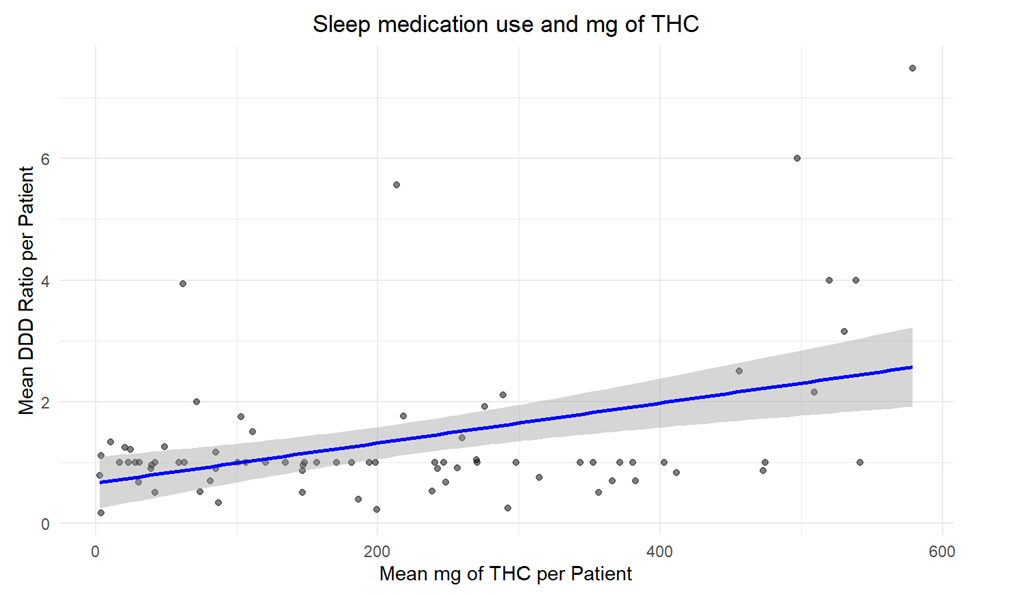
Conclusion
These preliminary findings suggest that cannabis has the potential to significantly reduce the use of traditional sleep medications, particularly among older adults. The preference for specific forms of cannabis in patients using high doses of sleep medications, and a higher effectiveness of capsules in reducing its use highlights important considerations for patient preferences and adherence. As MSA continues this research, we aim to further elucidate the mechanisms behind these trends and refine our understanding of how cannabis can be optimized for managing insomnia and sleep disturbances.
Additionally, MSA aims to support the development of comprehensive guidelines to help clinicians incorporate cannabis safely into insomnia treatment plans. A high-level of evidence from real-world data can help regulatory bodies to update policies based on the latest research and implement educational programs for both healthcare providers and patients about the safe use of cannabis for sleep disorders.
If you are interested in learning more or getting involved with MSA by being a prominent leader in cannabis research, we’d love to hear from you. You can reach out to Madeline Grant at mgrant@msa.com to schedule an introductory call.
Committee Blog: Time to Hire

The road to opening a licensed cannabis business is a long one. You have managed to navigate through a competitive and complex licensing process. You have convinced your local community to give your company a shot. You have beautified the area surrounding your business. You have secured your supply chain, and you even opened a special account at a cannabis bank to deposit all that cash. You have hired armed security, and even though you are paying the company 3X what you’re making, it’s okay because you and your staff are safe. You even survived the facility build-out, and hopefully, you have about six months of capital. What an accomplishment. Bravo! You did it! Wait… you need a team to help you operate this beast. Time to hire!
I heard someone say, ‘Great things in business are never done by one person. They’re done by a team of people.’ I would guess that if you have made it to the finish line, you’re likely to already have a team. Now it’s time to expand that team. As if the odds aren’t already stacked, in the fast-paced world of cannabis retail, turnover rates are hitting a staggering 55% within a year, per headset.io as of November 2023. I learned about this very early on when I began my research. I needed to know why and what I could do to avoid more than half my staff quitting within the first year. There were some common factors that led to employee attrition. I was a bit surprised to hear that pay wasn’t a top factor. What I learned was budtenders, in particular, didn’t feel the company provided any kind of staff development. Many instances described a poor management staff, and many felt unappreciated and overworked.
When we started this thing, it was important to make sure we could create opportunities for others. I’ve worked for both big and small businesses, some corporate and some non-corporate. I have had some good managers and some bad ones. I learned something from each job I’ve held. I vowed to make sure my staff never looked at our managers and our company and put us in the bad category. Trust is earned, and leadership can never be forced. I opened doors on April 22nd, and we hired 21 part-time employees. I will follow up in 12 months to see if I beat the odds. I’ve done it before.
It was through the NCIA network I met Carlo, and he had me go through a workshop. What I learned was, first, we needed to ask ourselves: What are our principles at Banyan Tree? My team is amazing, and we have been together so long we trust in each other’s expertise to maintain a harmonious environment. We want to make sure the staff feels the same way. So collectively, we created a list of principles. Next, we posted the job position. The response was overwhelming. Within 24 hours, we had close to 500 applications. We narrowed that down to 50. We scored the candidates based on their work experience and the video response they provided, aligning with our principles. Next, we scheduled the interviews. We called each candidate to share what they could expect during the interview. We sent them the list of our principles. We would be conducting the interview using the S.T.A.R. method: Specific, Task, Action, Result. That means the questions we ask will all be related to their work experience. We expect the answers you give to describe an experience that uses the S.T.A.R method response. It really helps us get to know the candidates during the interview, and you can tell someone is being genuine when they can recall an experience they had while working at previous jobs. There were about 21 of those interviews that went on for a full hour. We hired 21 amazing people. They all feel like they are part of something special. It’s my job to keep my promise.
It’s important to continue developing and educating the staff to help them get better at their skill. It is necessary to provide them with the tools they need to perform their job. Stuff like scanners and POS systems and card readers need to work. Technical issues disrupt the flow, but that’s controllable. Communication and trust are key. Without it, you’re doomed. Appreciation and praise go a long way. We need customers to stay in business, but we can’t do business without staff. My philosophy is that my employees are everything. As long as they love their job, our guests are going to reap the benefits.
















































